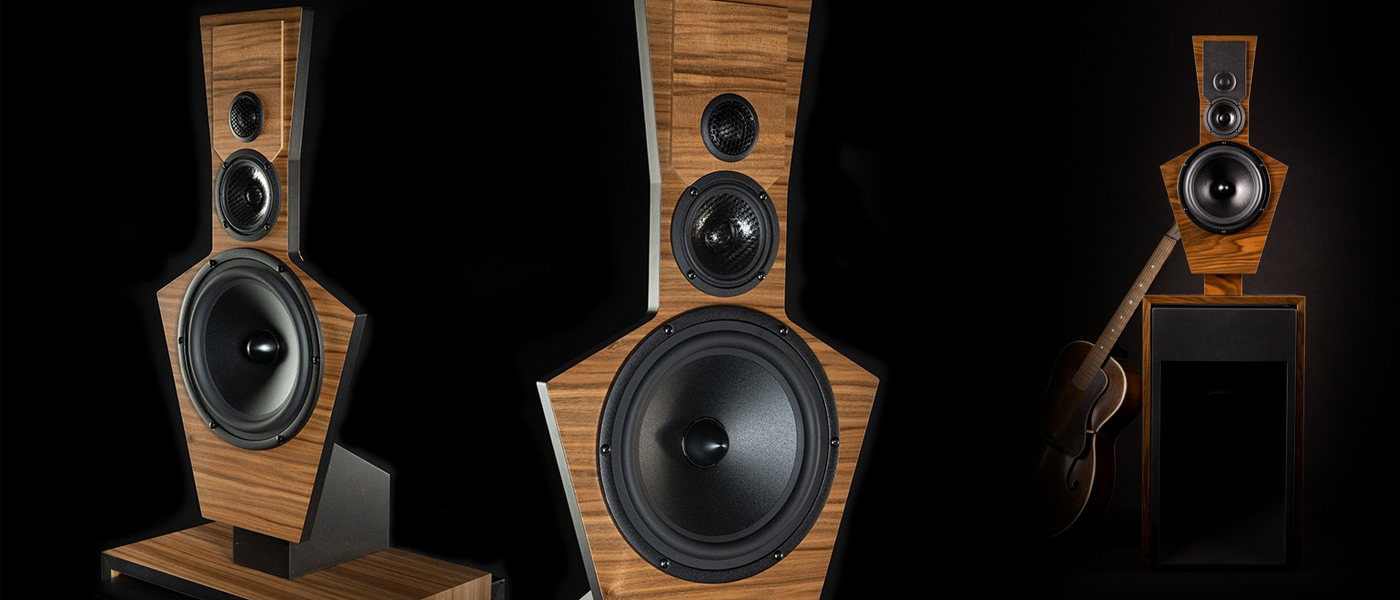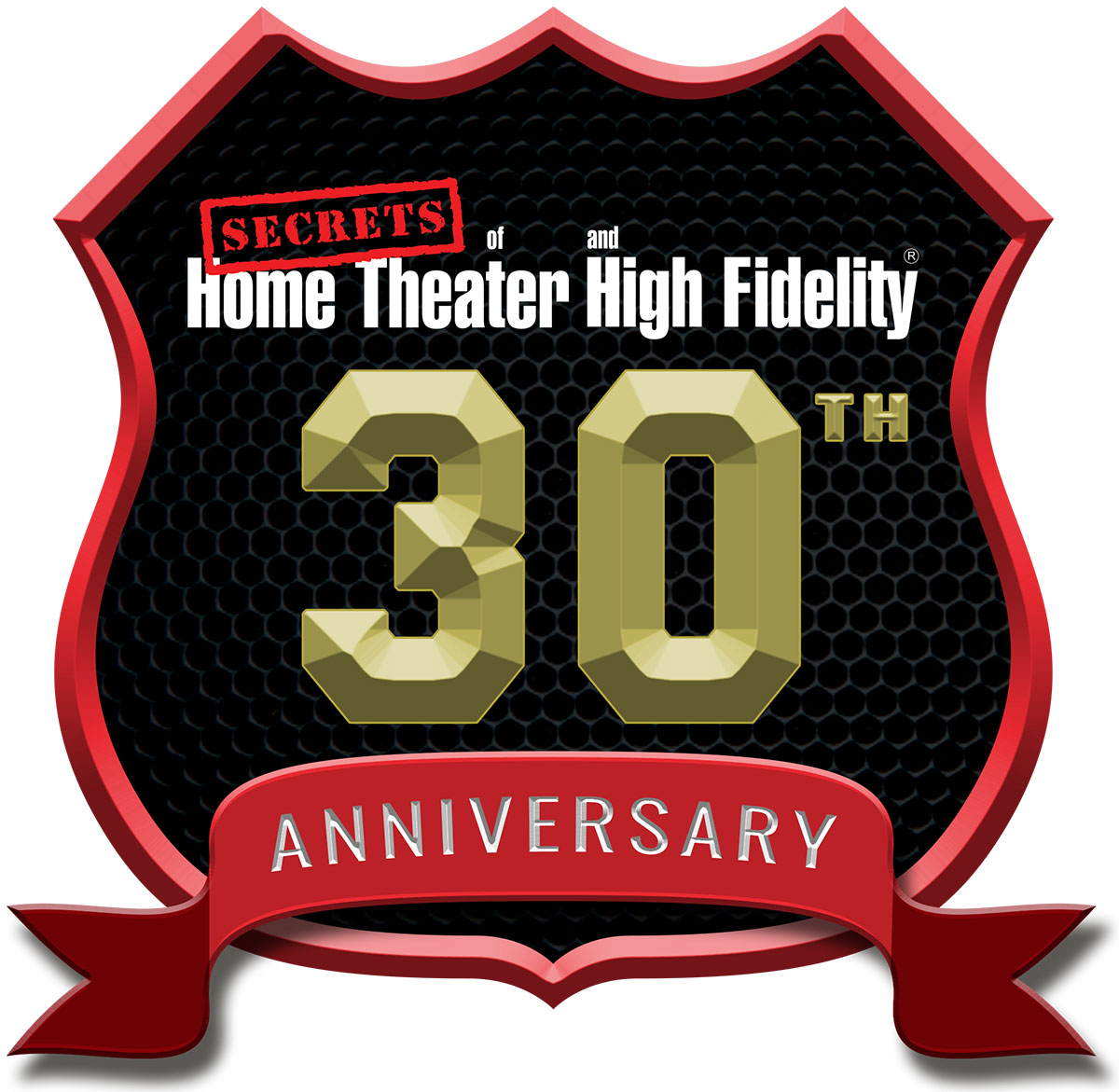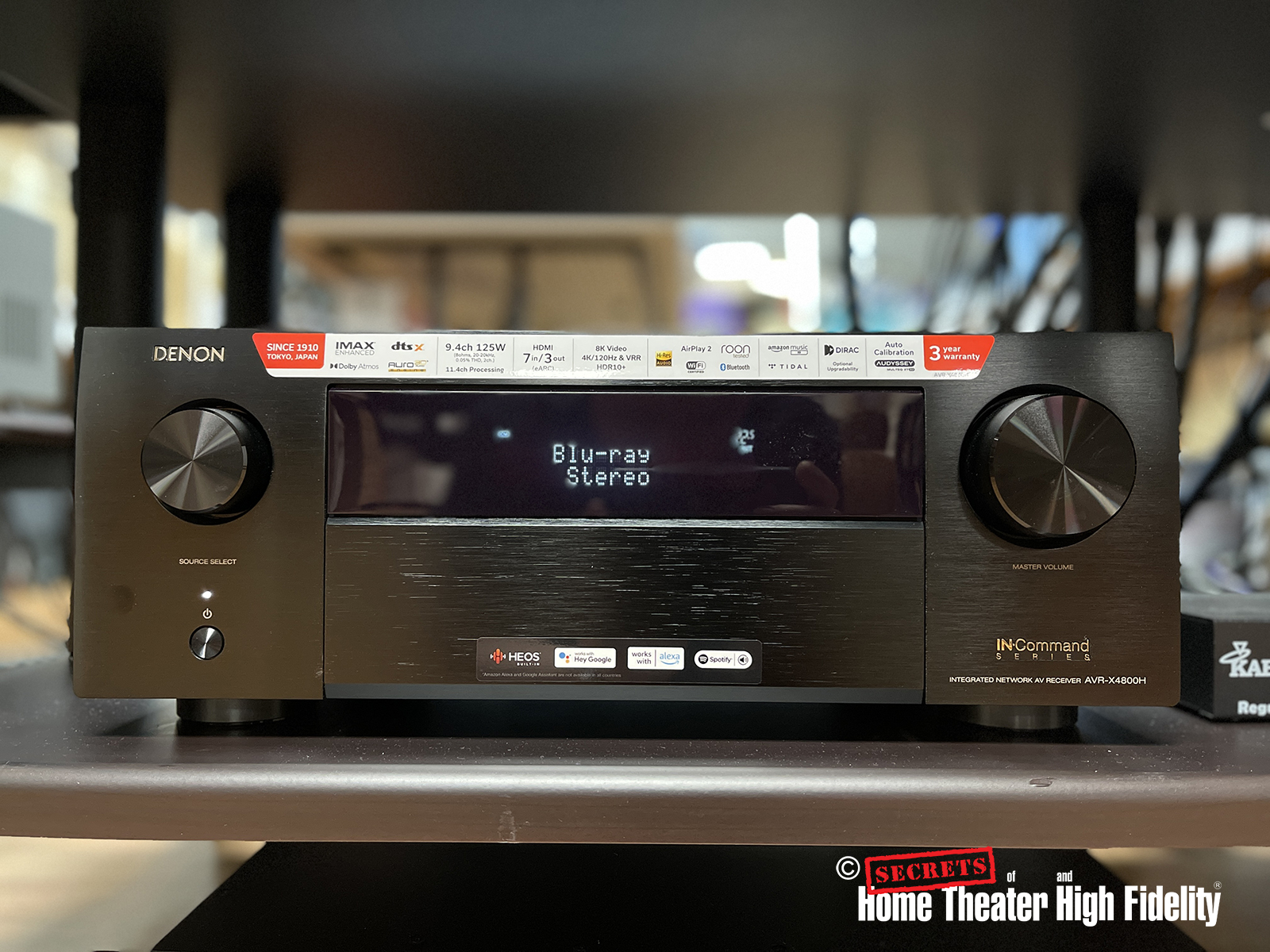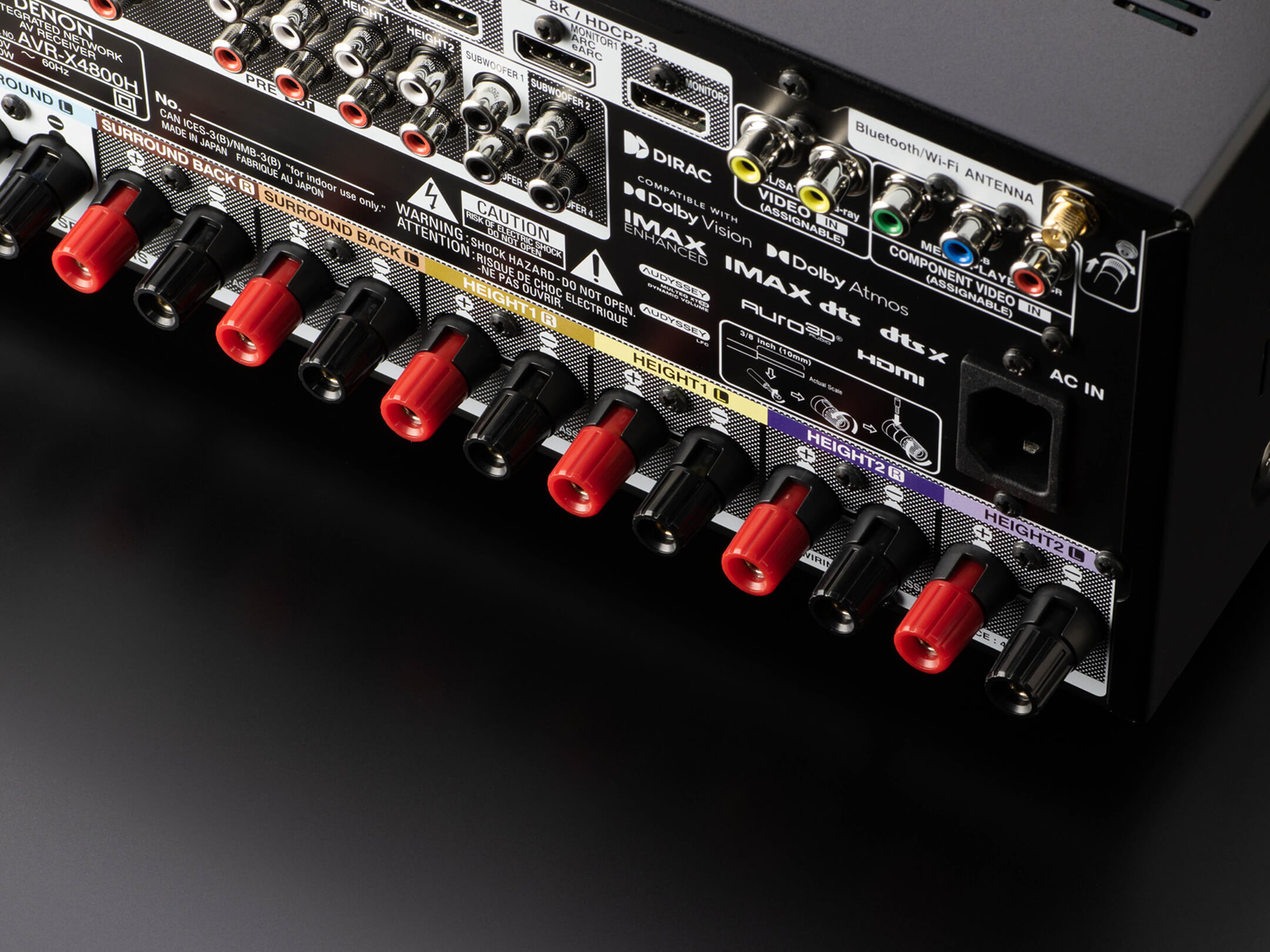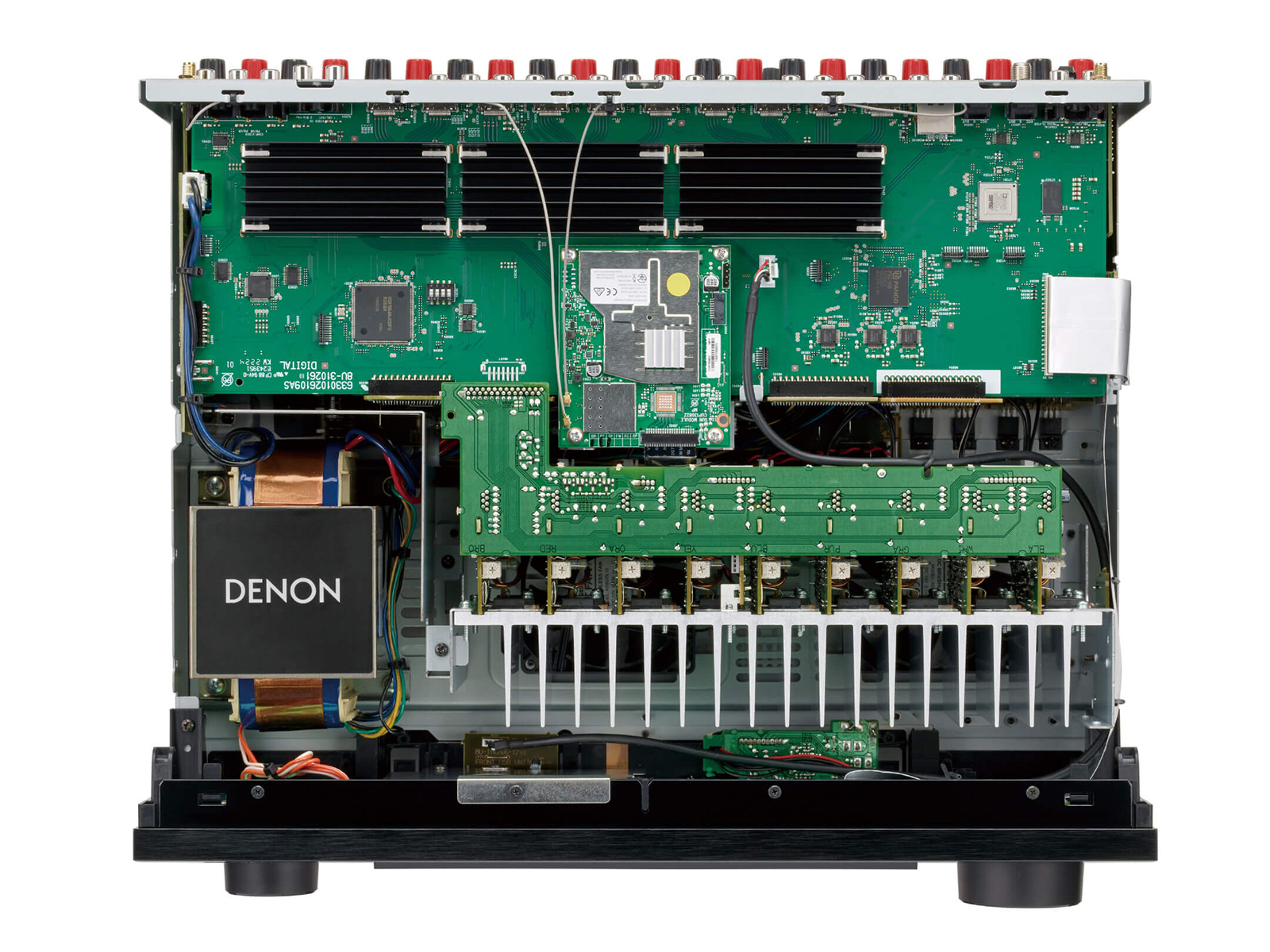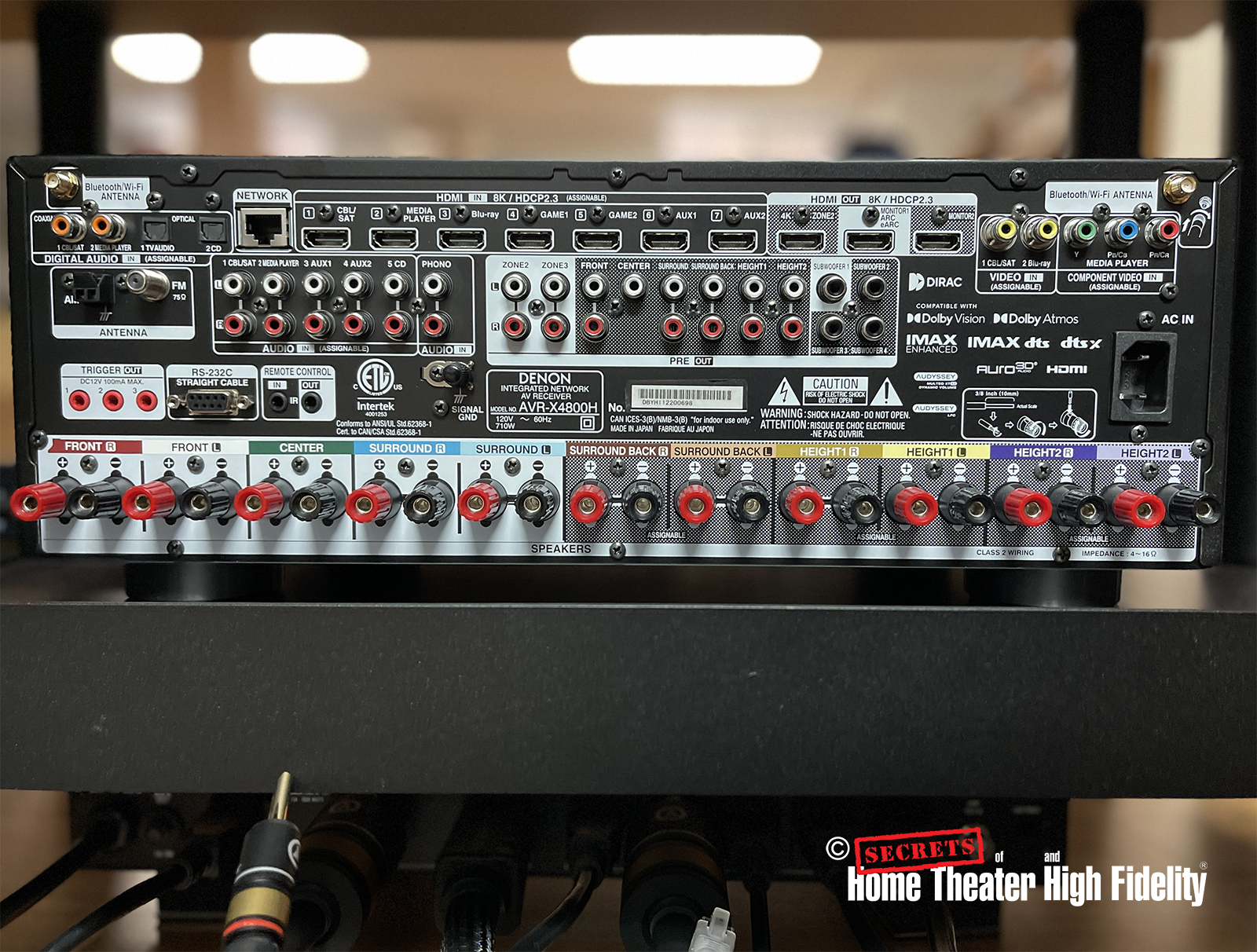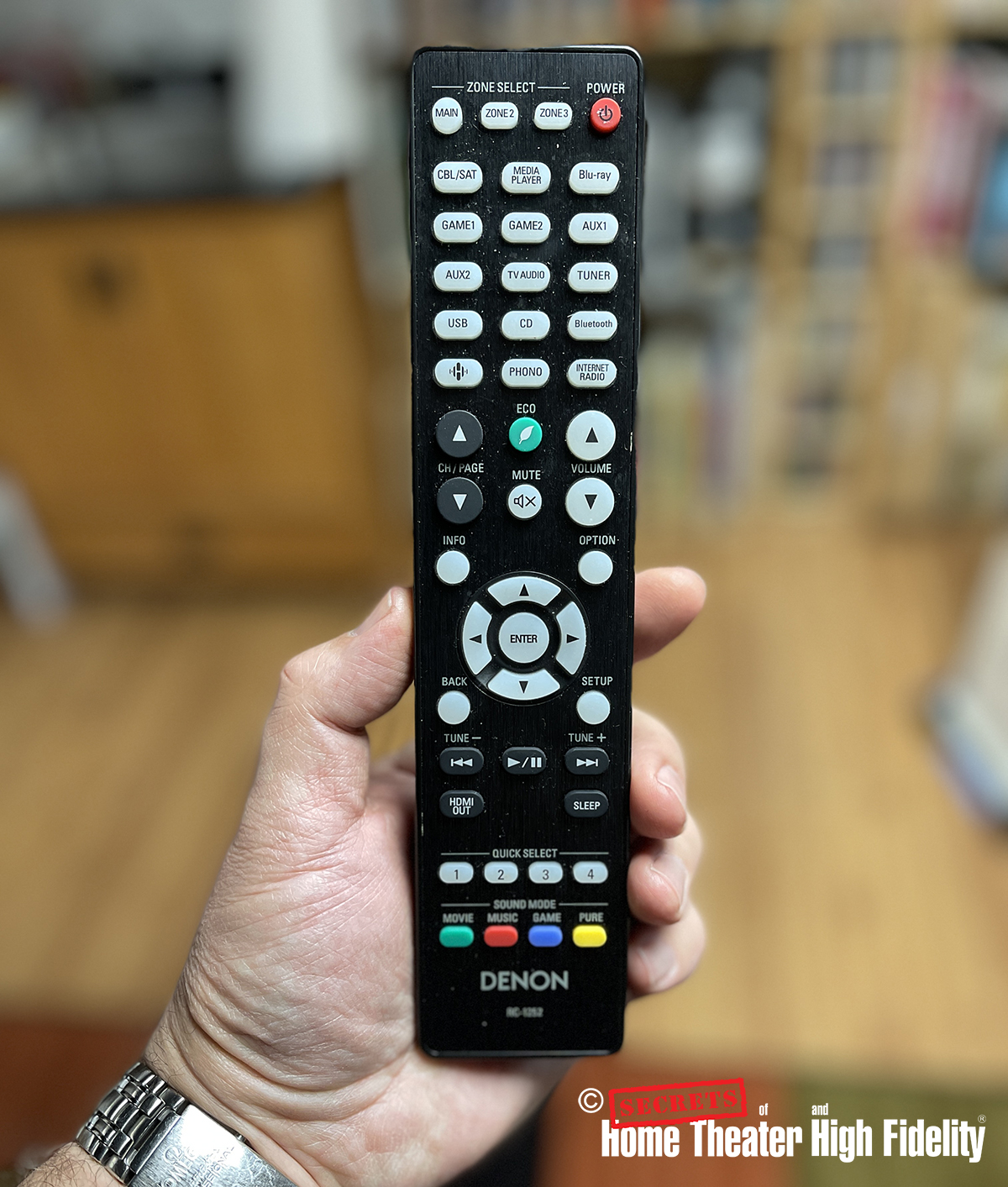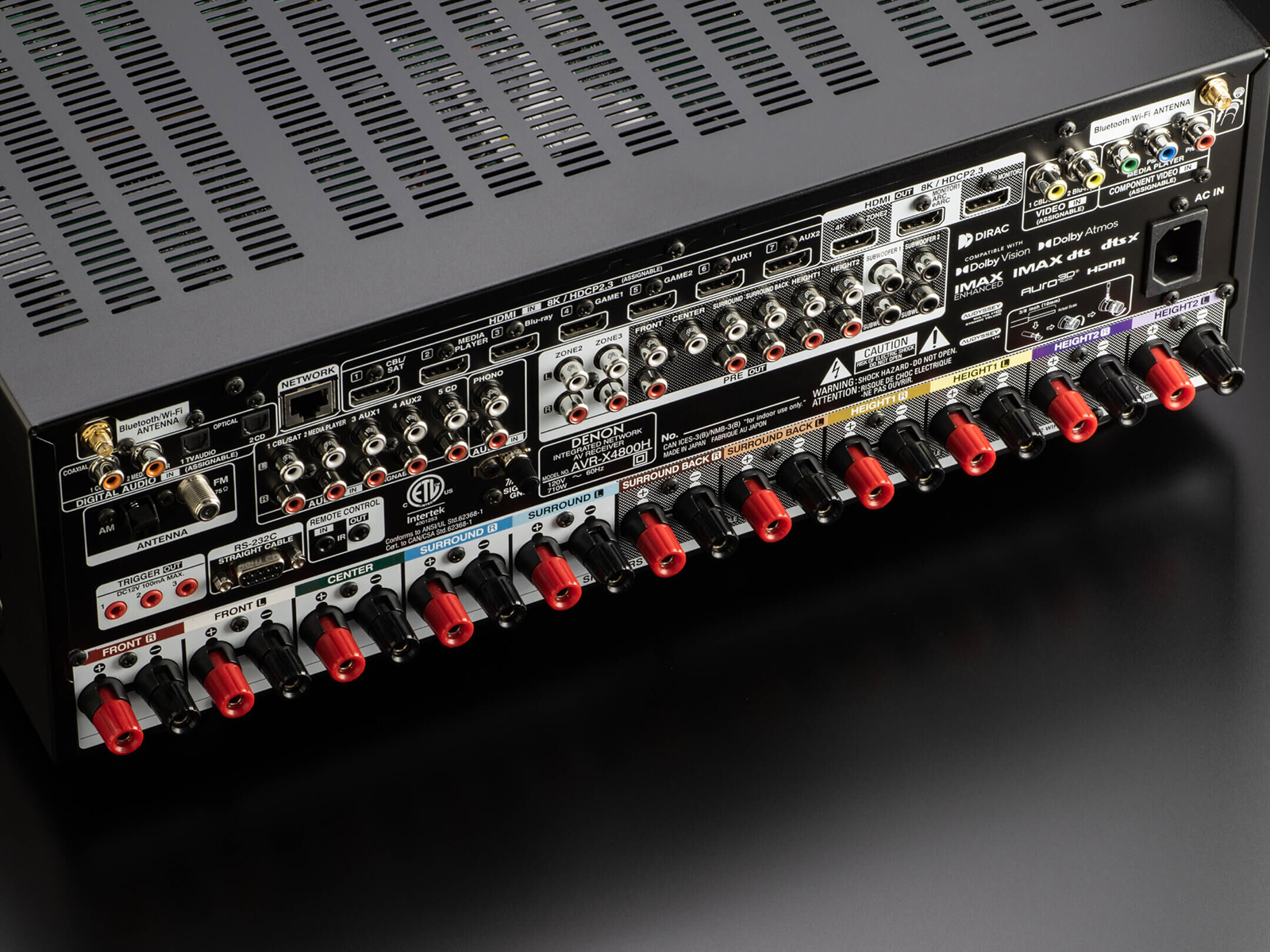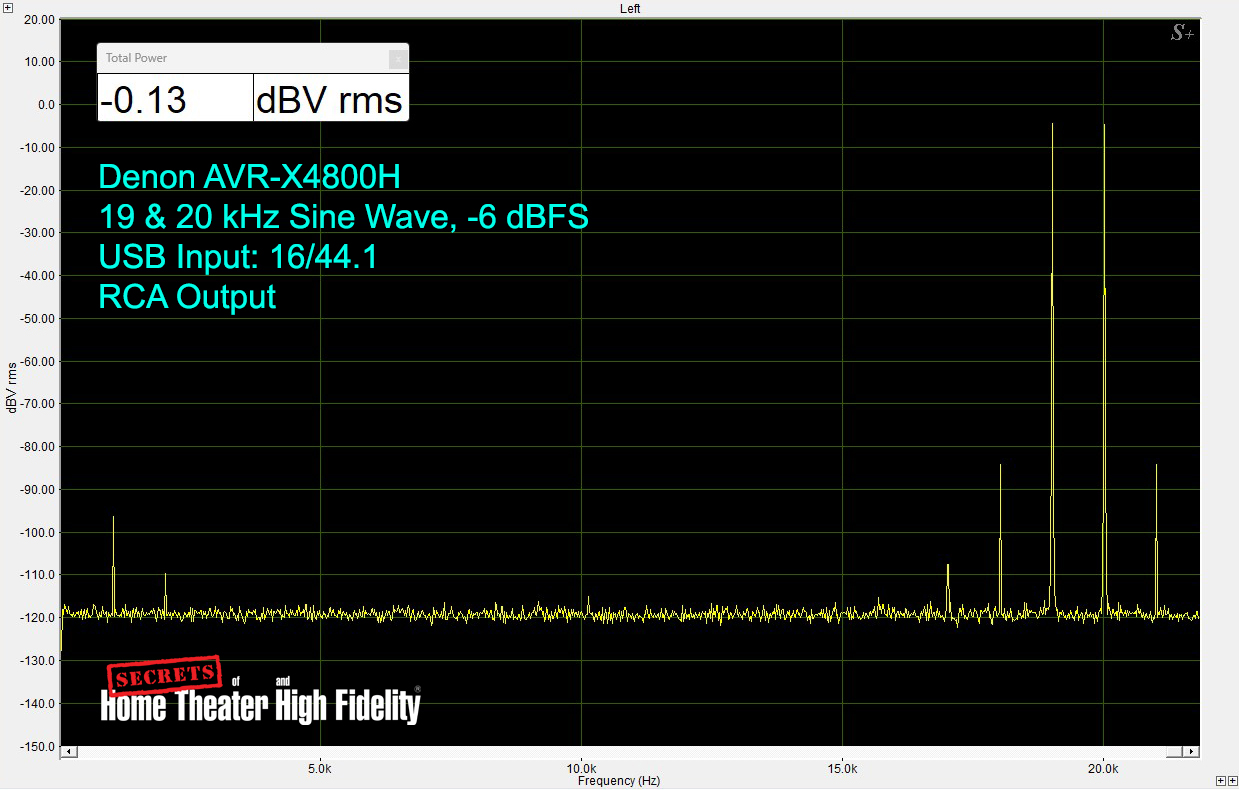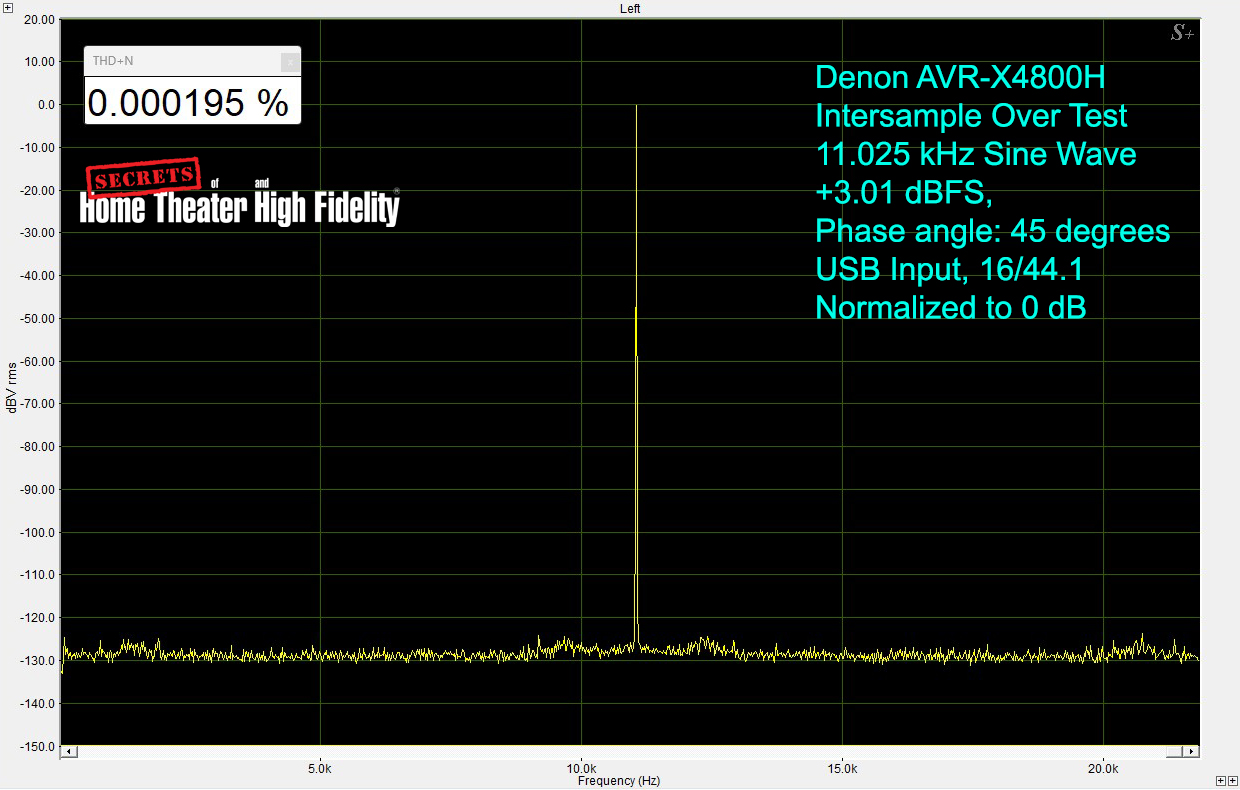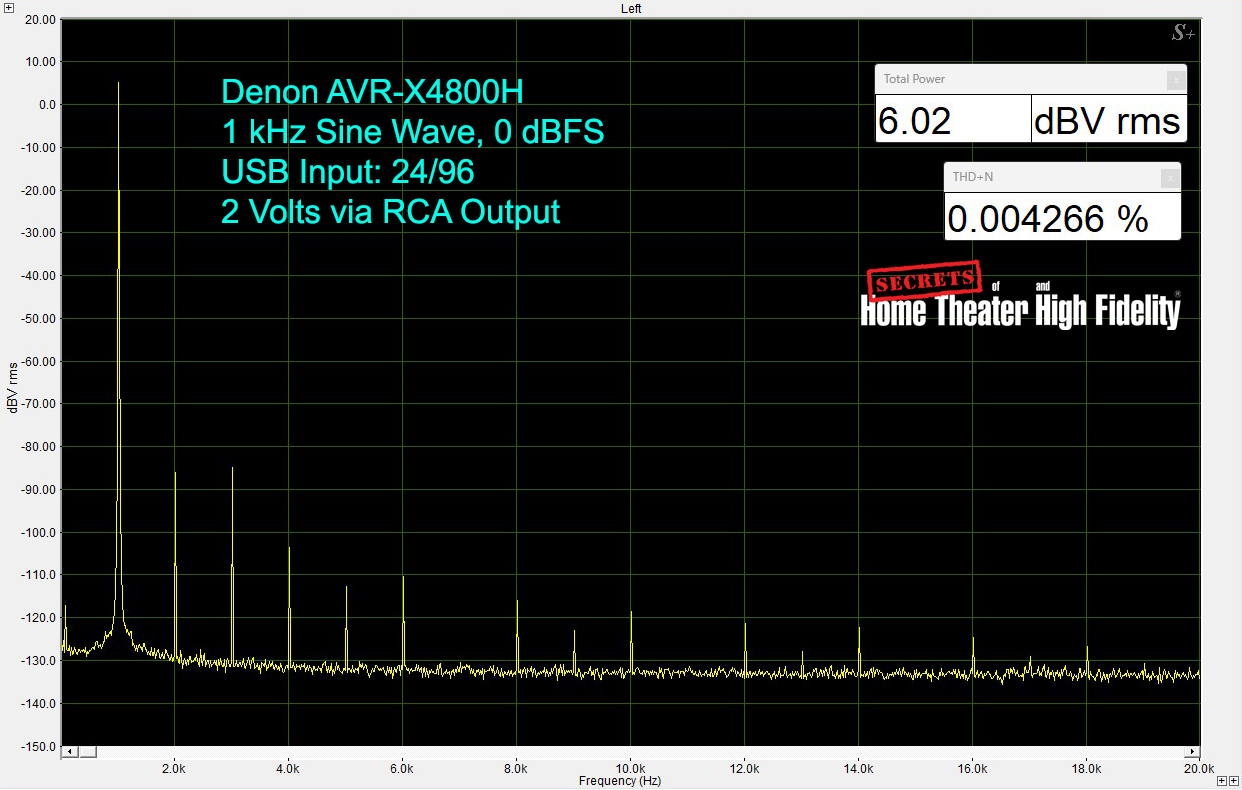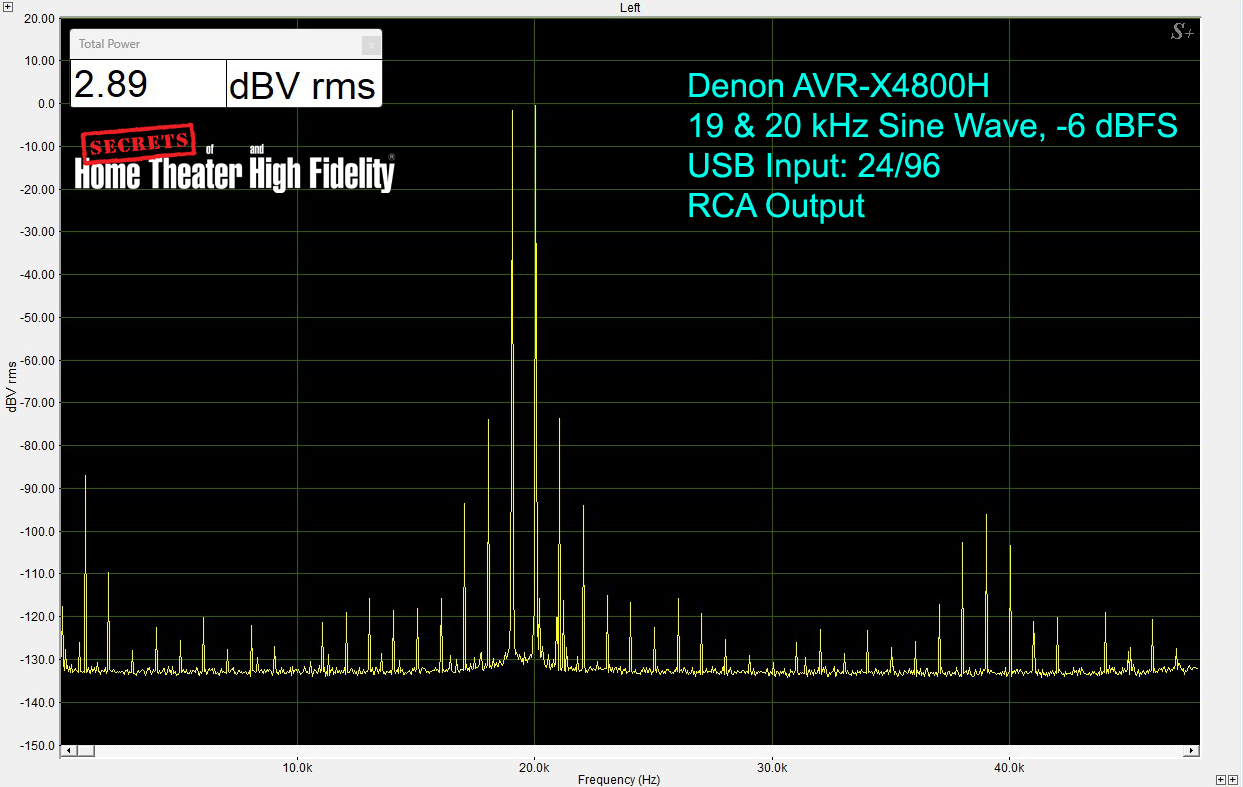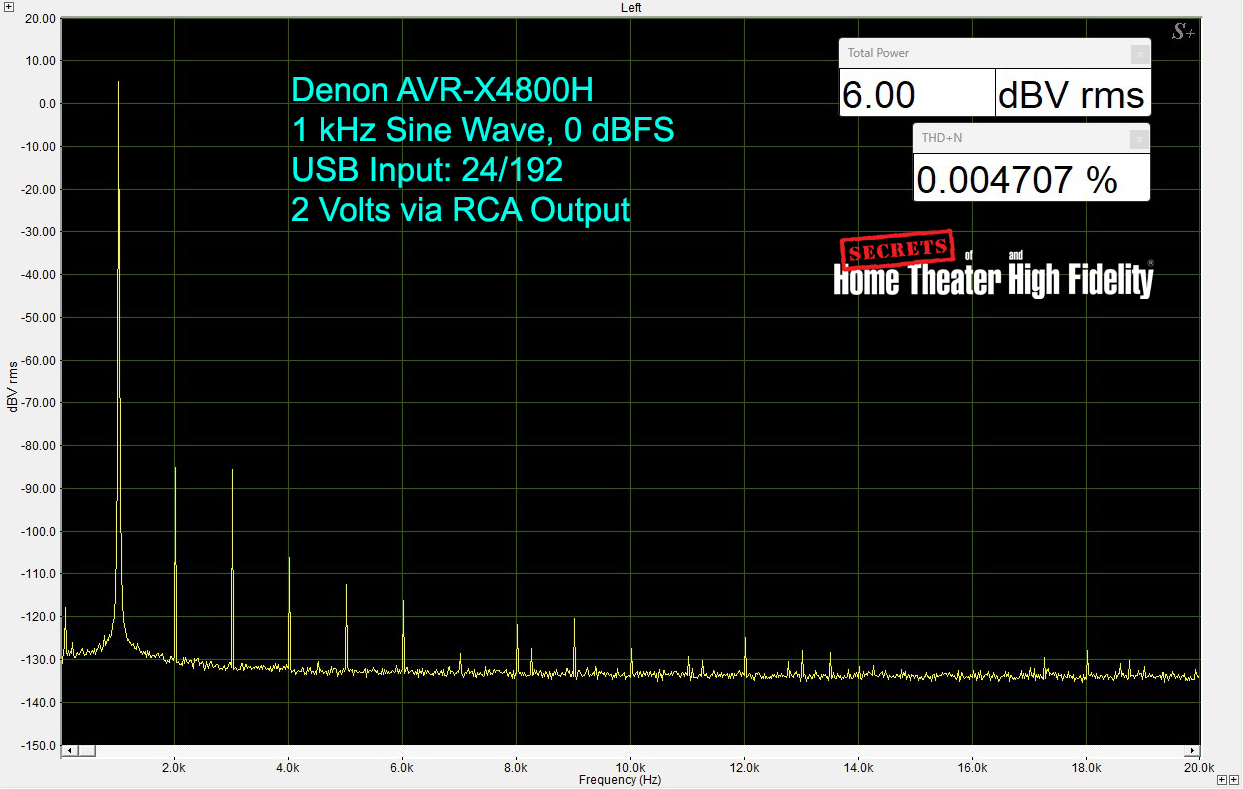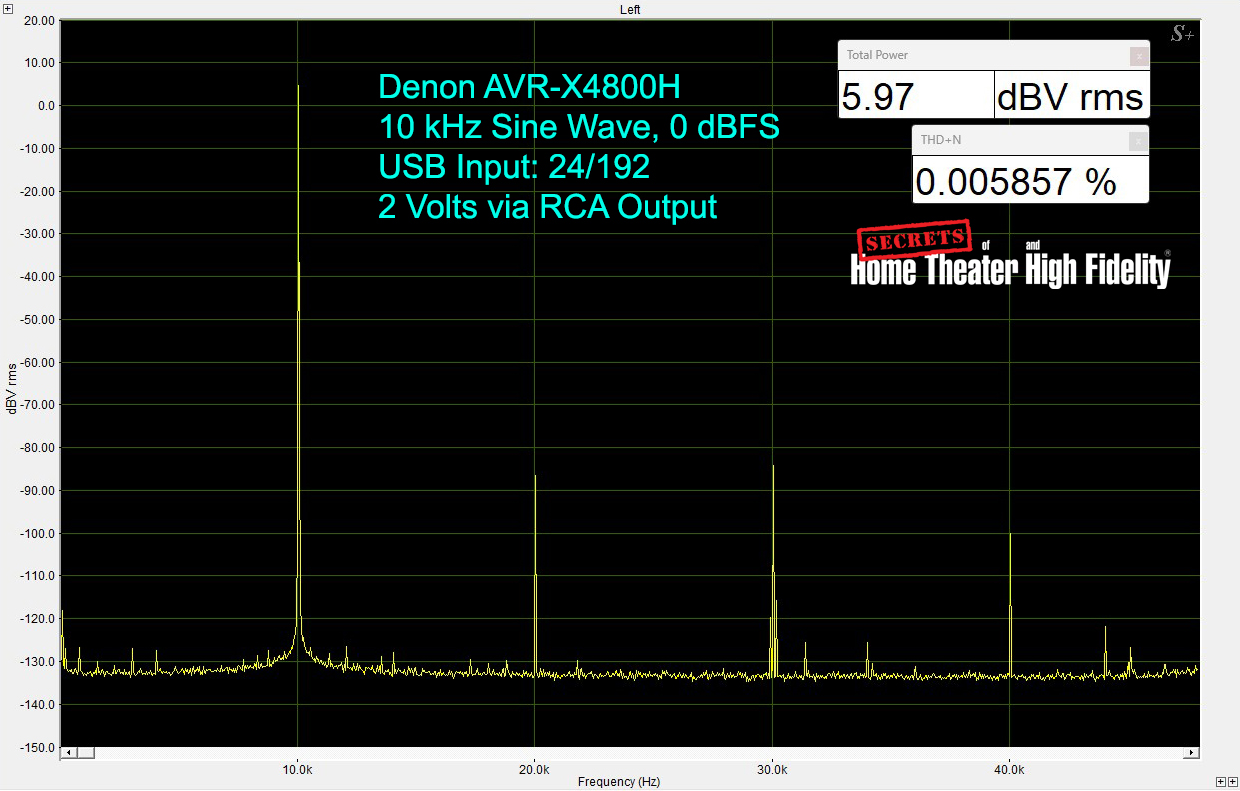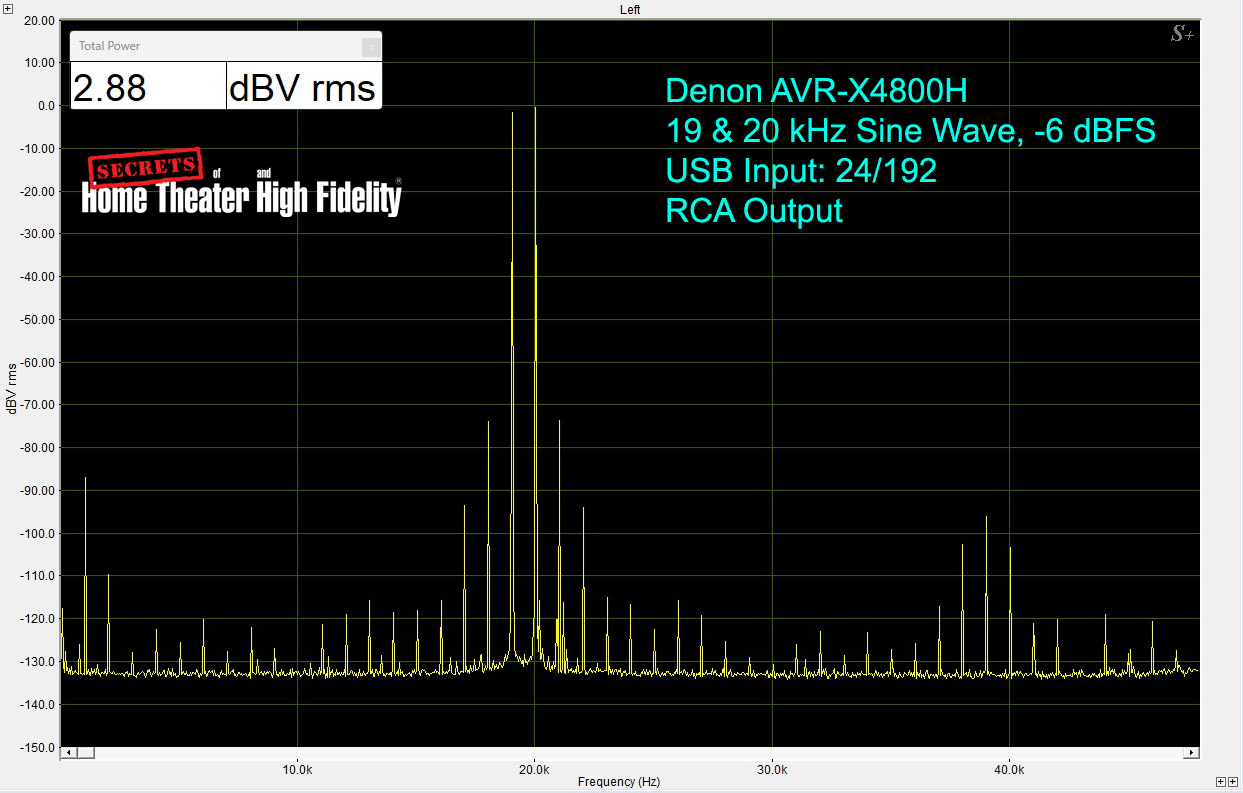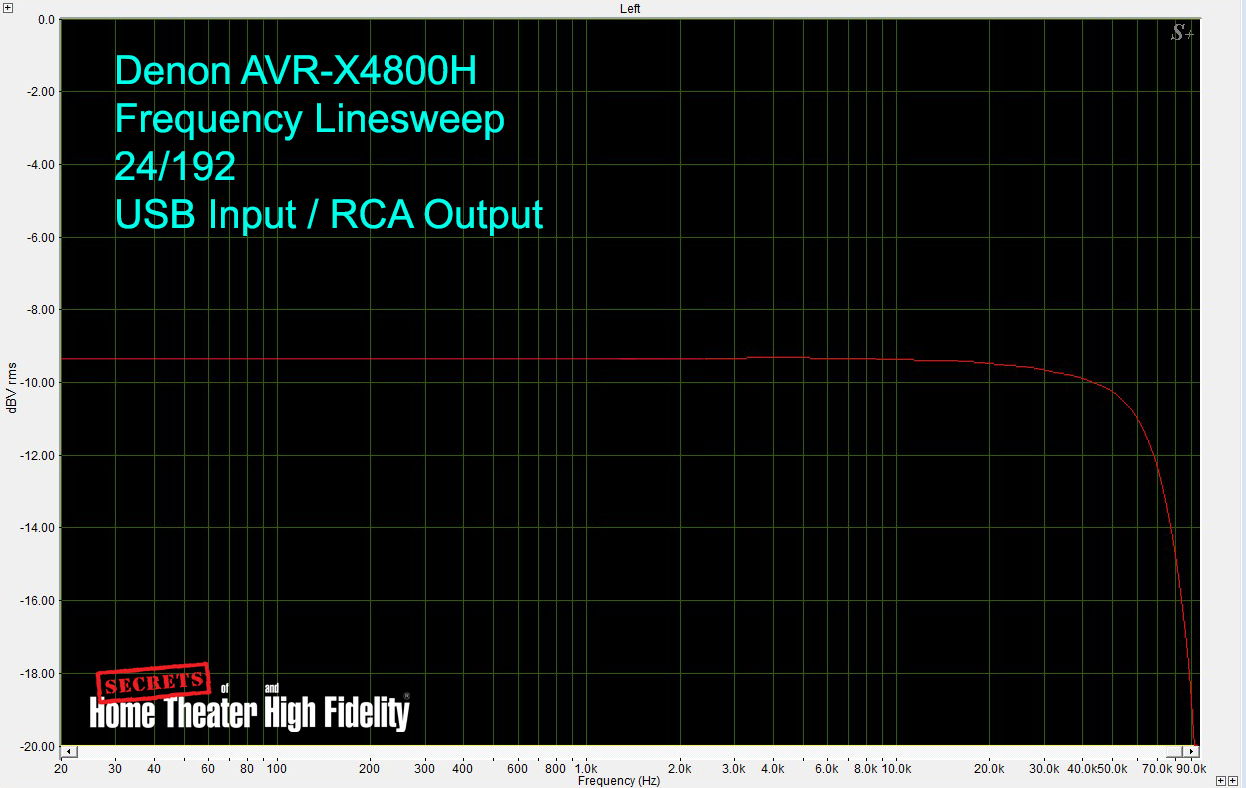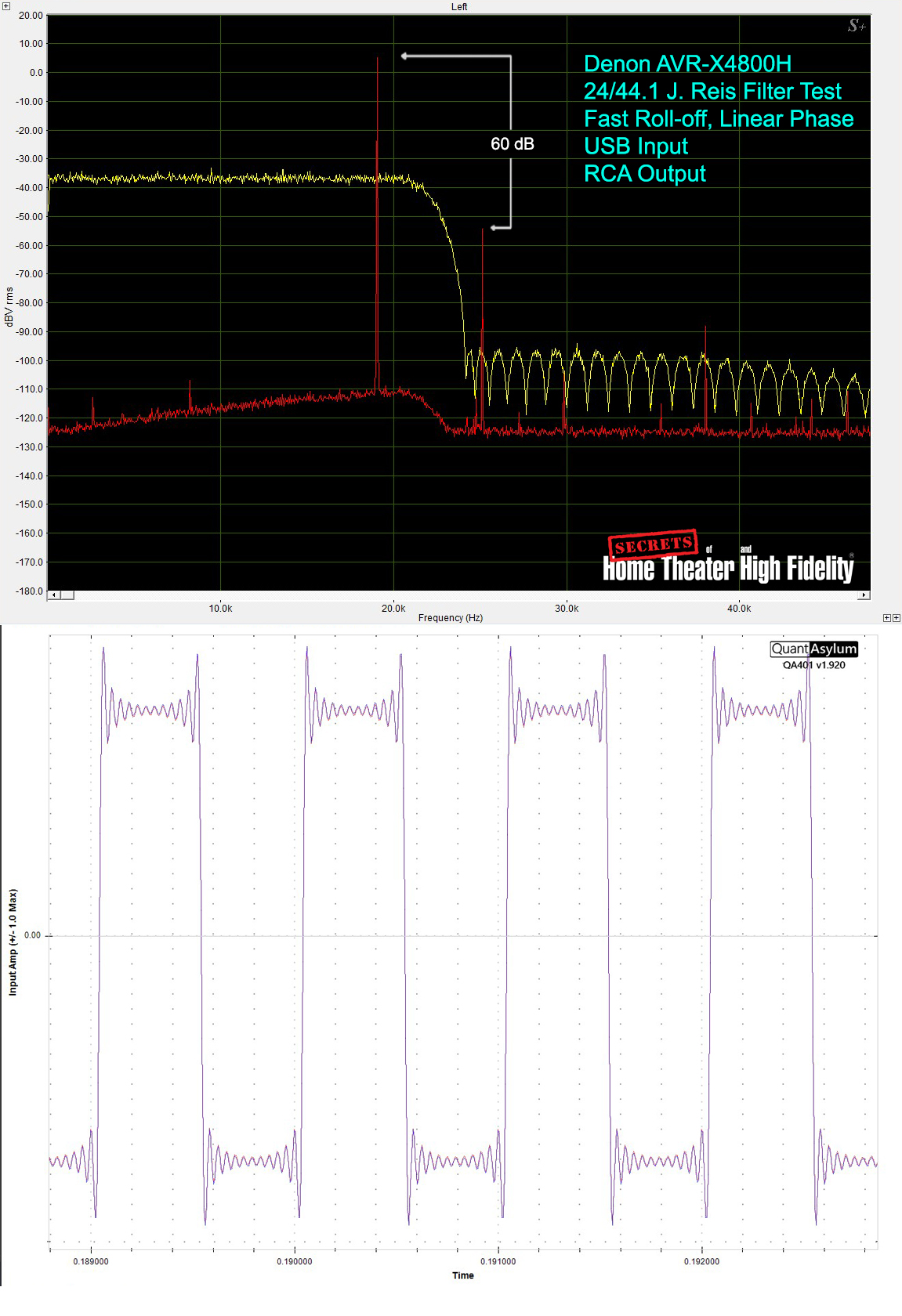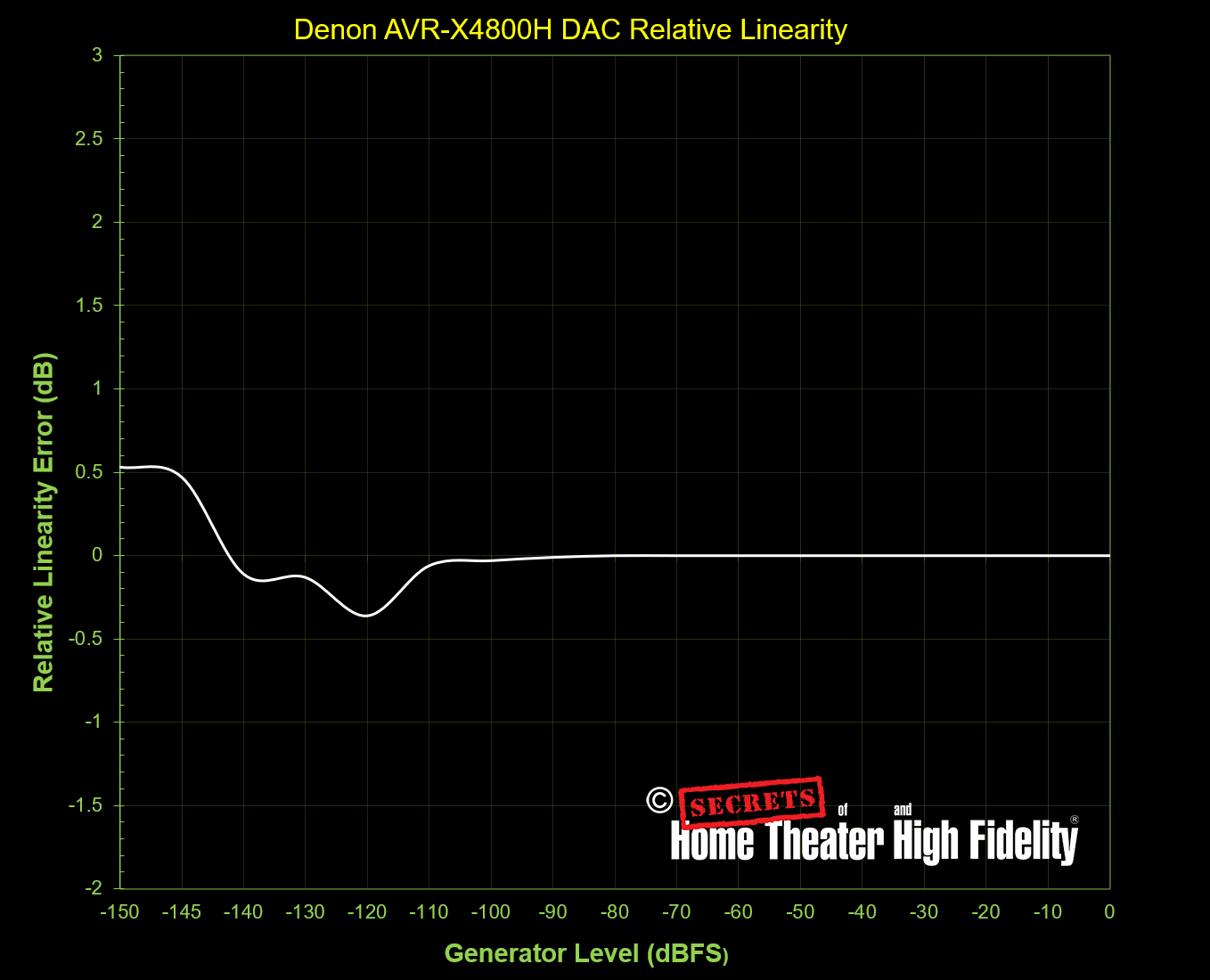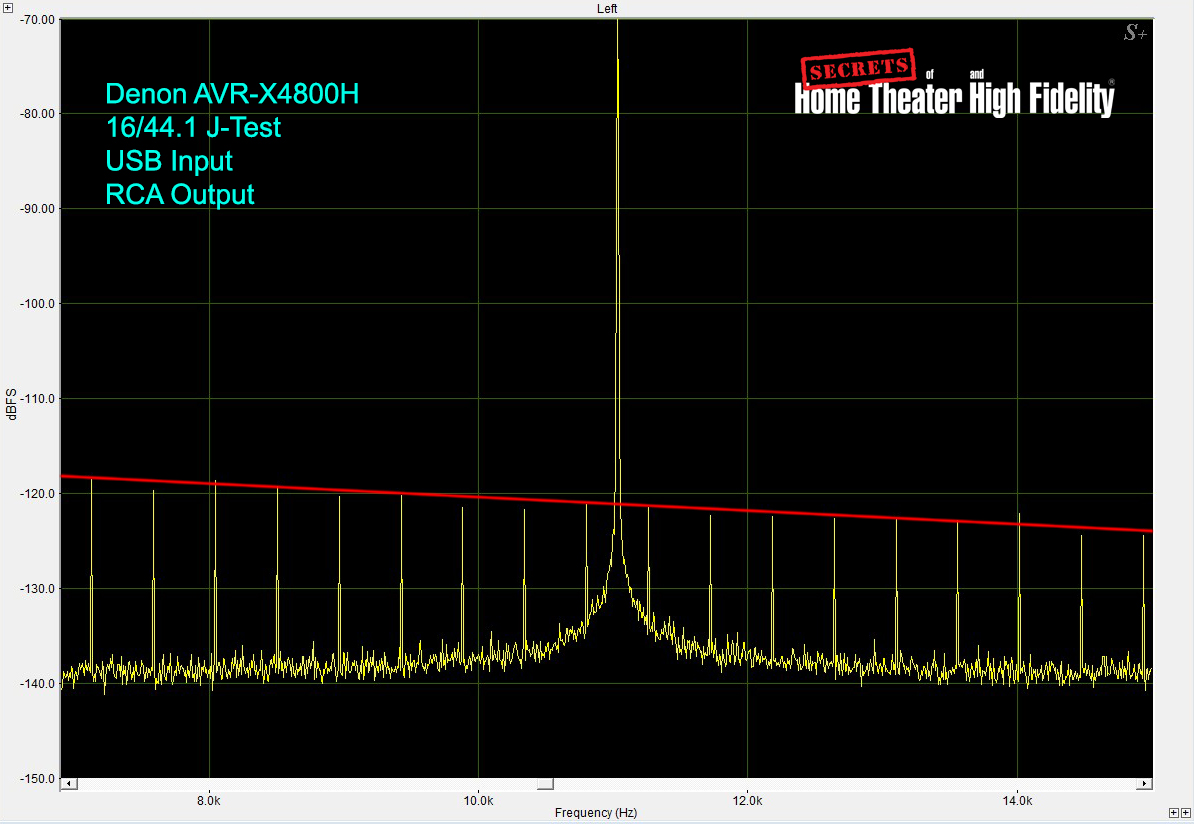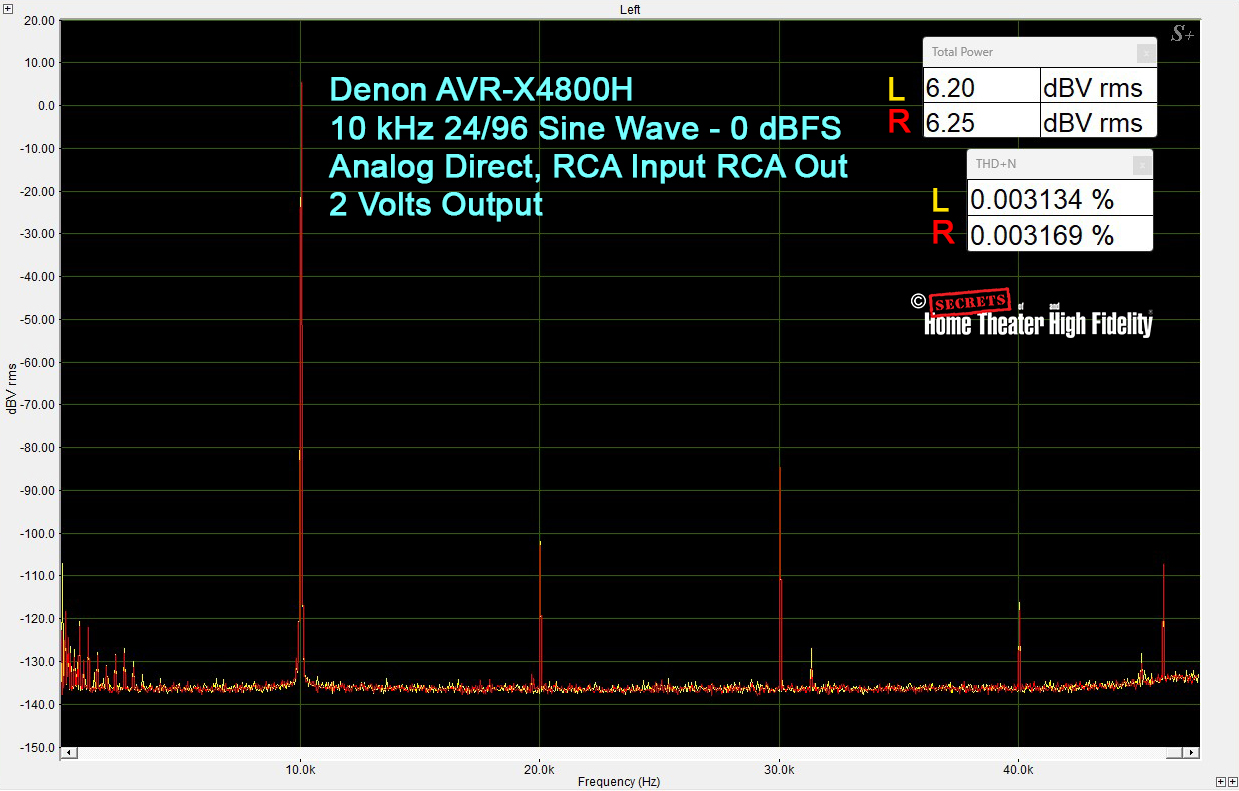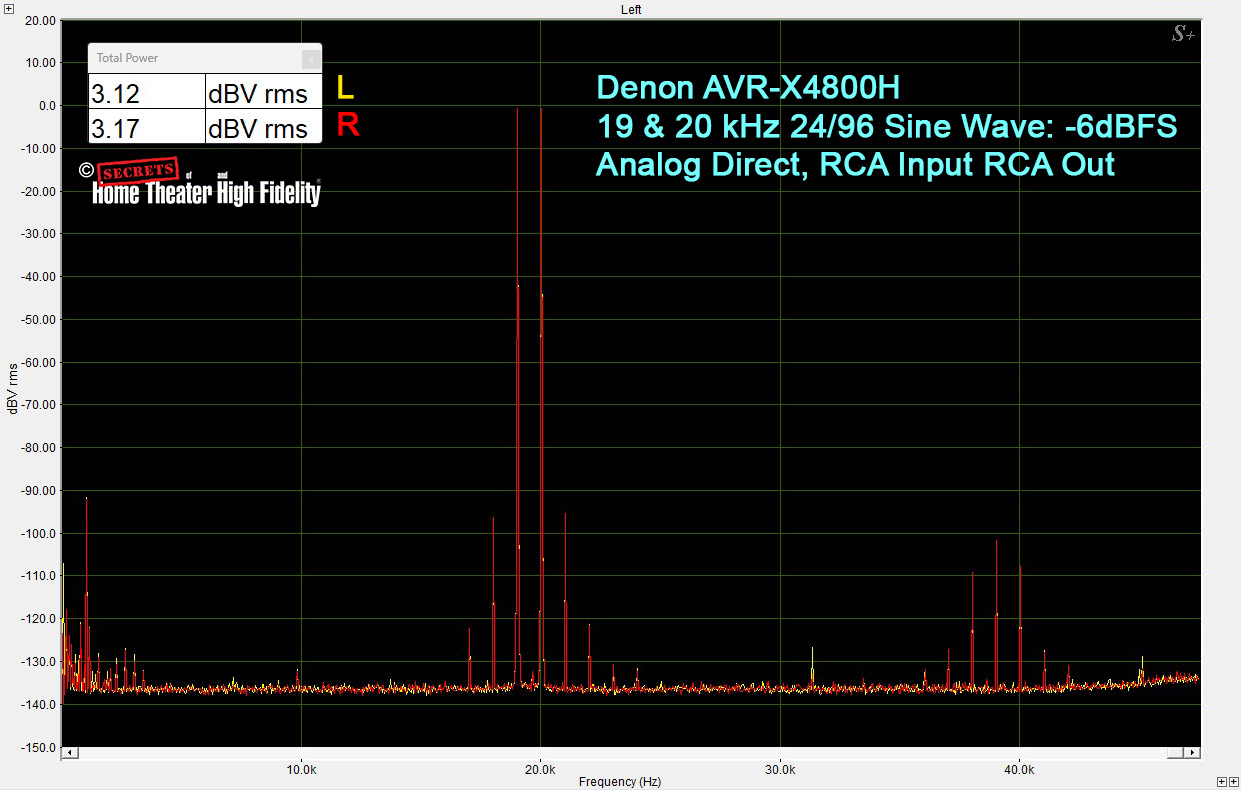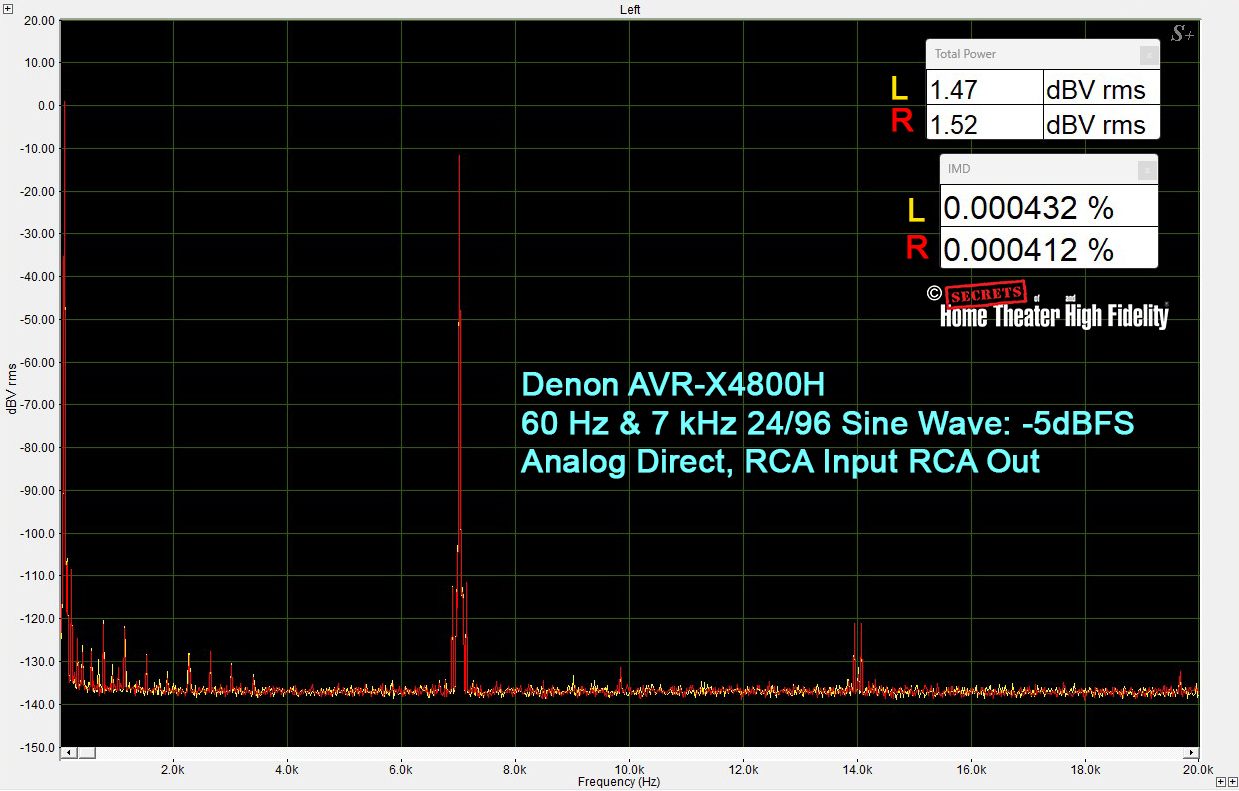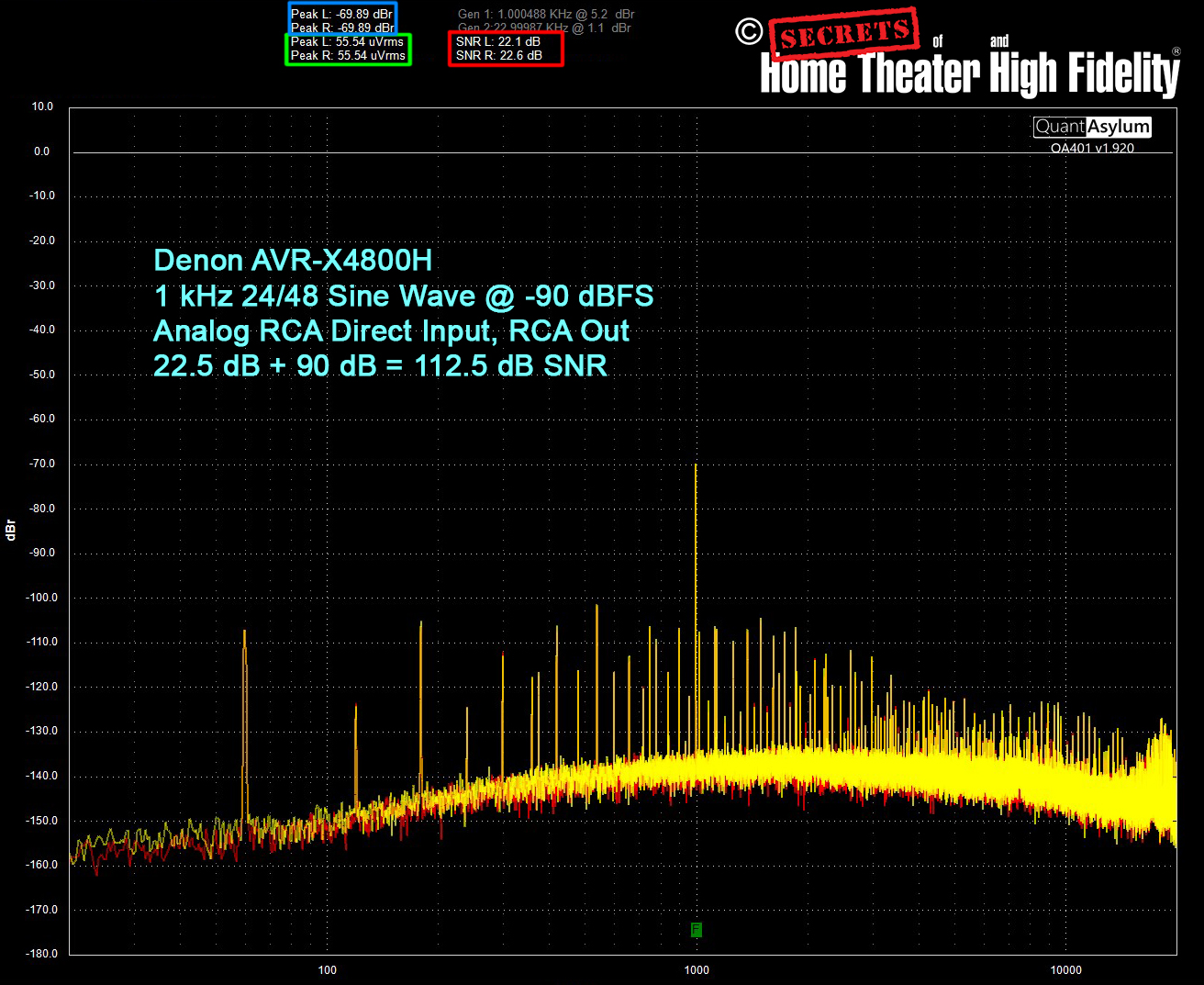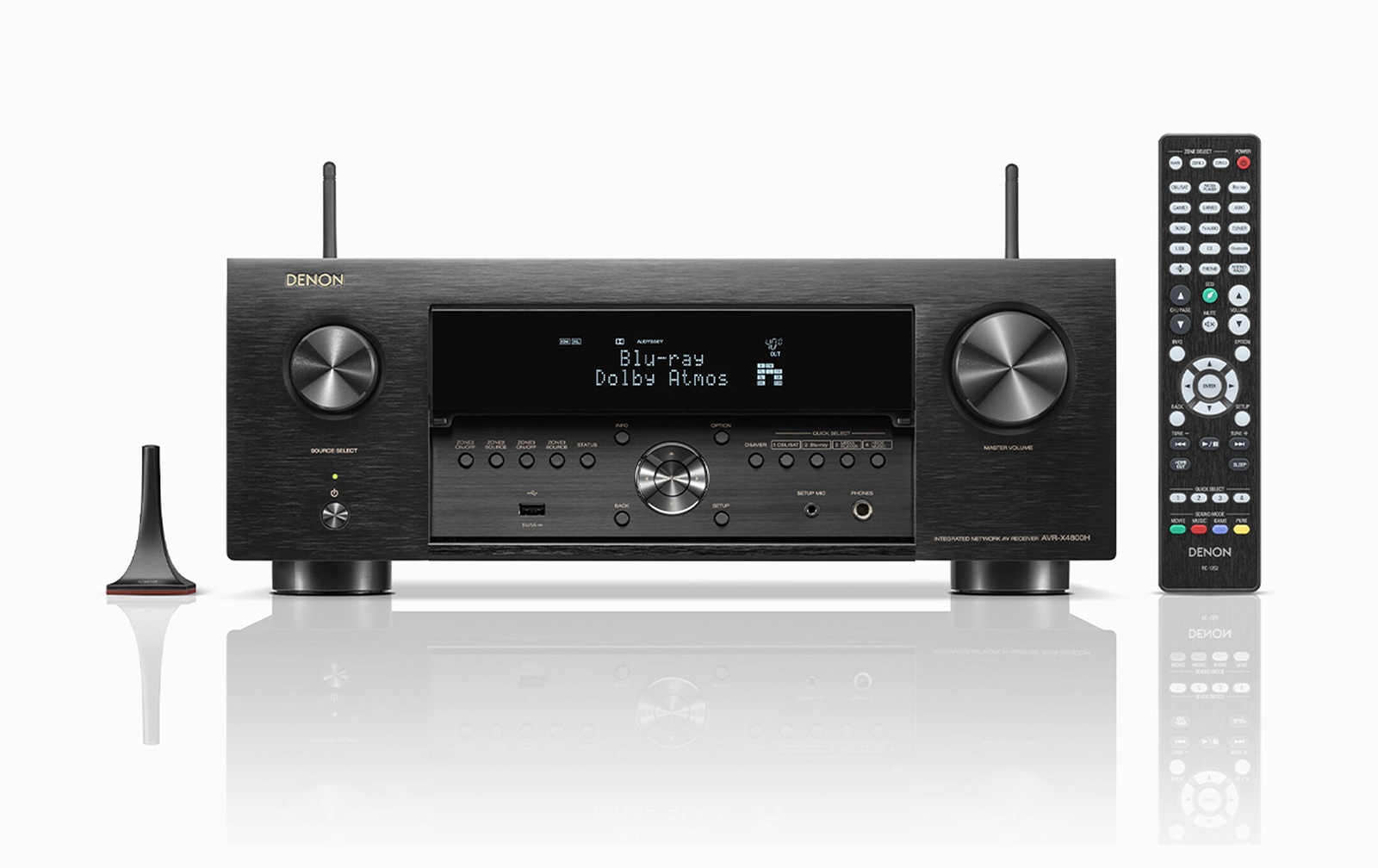Denon has built an excellent reputation for its home audio and video products over the last few decades, and in the latest series of receivers, it has stayed true to its roots. While many companies have gone to the “designed here but built in a country with cheap labor” approach, Denon designs AND builds the X4800H in Japan. It is loaded with features and can potentially be the hub of one’s home theater and music system for the foreseeable future.
Denon AVR-X4800H AV Receiver Highlights
- 9.4 channel receiver with 9 x 125W onboard amplification.
- FOUR independent subwoofer channels.
- Pre-outs for 11 channels.
- The Amplifier section can be turned off to make the X4800H into a pure pre-amp/processor.
- 11.4 channels of processing power in the pre-amp section.
- 8K Ultra video upscaling and HDMI pass-through feature with HCDP 2.3 support.
- Audyssey XT-32 built-in with DIRAC Live option.
- Full Wi-Fi and Bluetooth support.
- Wide array of surround modes.
- Denon “set up assistant” GUI for easy installation.
- Excellent 2-channel performance from CD/USB.
Some 20-plus years ago, I purchased a Denon AVR-5800 for my state-of-the-art home theater. It was a 6.1-channel receiver that re-wrote the rules for what was available in terms of a high-quality AVR. It was also $3800 in price, which would be $6480 in today’s dollars (which also happens to match the current AVR-1H flagship receiver from Denon). Except for power output, the AVR-X4800H outguns the AVR-5800 at every level. It has more features, far superior video processing, and Audyssey room correction (if you are old enough, you remember what “room correction” was circa 2001. This was using a Radio Shack SPL meter and test tones from the receiver to manually set levels. Room correction as we know it today was a distant dream.), more surround modes and future-proof upgrading. Denon managed to do all of this for less than 40 percent of the inflation-adjusted dollars while keeping the manufacturing in-house. This is an accomplishment, and the results are nothing short of astonishing in every aspect. Let’s dig in further to find out why.
Power Output:
125 Watts per channel (8 ohms @ 2 channels driven, 0.05% THD, 20Hz-20kHz)
Video:
HDMI In/Out: 7/3 with full 8K video
Phono MM:
Yes
Digital In:
Optical (2), Coaxial (2)
Multi-room out:
Analog (2), Digital (0)
Multichannel pre-out:
Yes (11.4)
Subwoofer out:
4 independent channels
Speaker terminals:
11
Speaker A/B:
assignable
Bi-Amp drive:
assignable
Multi-room speaker terminal:
assignable
Auto speaker set up:
Audyssey XT-32 standard, DIRAC live upgradable.
System remote control:
RC-1252
Power consumption in watts:
710
Dimensions (W x D x H):
17.1” x 15.3” x 9.3”
Weight:
Net 29.1 lbs.
MSRP:
$2,499.00
Website:
Company:
SECRETS Tags:
denon, home theater, receiver, avr, heos, audyssey, dirac
- McIntosh MHT300 Home Theater Receiver Review
- Secrets: Marantz CINEMA 40 AV Receiver
- Marantz CINEMA 60 AV Receiver Review
The AVR-X4800H shows off the detail and quality one expects from a Japan-made audio receiver. The chassis is solid and feels like a more expensive component. The front panel knobs are substantial, a nice touch, especially considering they will rarely be used. The supplied remote control has a carbon fiber face and while it is light, it is also a testament to excellent quality control. There are no sharp edges or noticeable seams on the remote or the main receiver. The front channel display offers a complete view of any signal format one is using, including the speaker assignments.
Secrets Sponsor
The back panel is very well laid out, with decent spacing between inputs. It was refreshing to not have to resort to profanity while trying to run all the needed cables to the right spot! The inputs themselves are all solid, with no movement or feeling of fragility when plugging in RCA, HDMI, or speaker cables.
Secrets Sponsor
The features are almost endless, including Dolby Atmos, DTS:X, Imax Enhanced, Auro 3D, 360 Reality Audio, HEOS, Dolby Vision, and a host of other items. The Denon AVR-X4800H is so well-equipped that it might be intimidating. Don’t let that deter you. Instead, think of it as a product that will grow with you over the years. If you are working with your local audio dealer (always a good idea), this receiver will give them all the tools needed to help set up a great theater experience.
I would be remiss in not pointing out how important it is that pre-amp outputs are available for every channel. For the entry price of $2,499, the AVR-X4800H would be a bargain if used as a standalone pre-amp/processor. When a receiver has these pre-amp outputs, it allows an upgrade path simply by purchasing a separate power amplifier of three channels or more.
For the first time in my 30 years of reviewing, I am working without a service manual or schematic from Denon. In the PDF era, Denon sold them directly for a nominal fee. I just purchased them, but recently, Denon / Marantz stopped selling manuals. Thus, I will work from my knowledge of the AVR-X4500H, making inferences about the changes using some data available on the web. By far, the most significant circuit level change in the new AVR-X4800H is the DSP. We will see Moore’s law in action. The AVR-X4500H had four DSPs from Analog Devices. These were in the SHARC+ family. Denon used to call this board the “Shark Tank”. In the subsequent AVR-X4700H, the DSP chip count was reduced to just two. Today, the channel count is up, but only a single DSP is needed. It is the Analog Devices ADSP-21593. It is found in every new model from the AVR-X3800H out to the AVR-A1H.
This process technology is not the bleeding edge IC process that AI processors are shipping with. Those are cost-no-object designs. The process used here has kept or reduced the cost of the DSP functionality by reducing the number of chips and board space. The price of making the single chip can only be four times the four chips. The most straightforward way process engineers put this is the cost of making a single NAND or NOR logic gate must go down with a change in process technology. The ADSP-21593 has many more logic gates on the die, but the magic to being cost-effective is all those gates need to cost less than the gates on the two previous generations of DSP, which in turn had lower cost gates than the four DSP solution.
It is essential to understand that new chip technology coupled with new functionality can lead to buggy products. Producing bug-free products is something Denon and Marantz excel at. Much of this concerns the volume of products they make, but equally important is how long they have been doing it correctly. They have a robust internal team working on the products using SHARC+ chips to develop code and QC the complete product. The team has been together for more than a decade.
The number of channels has increased to 15. On top of that, the processor runs 15 channels of Full Bandwidth DIRAC Live. The DIRAC Live Bass Control is said to be coming but has yet to be on sale at the Dirac store, which lists models from all companies that require some optional Dirac license. Live Bass Control is not listed for Denon but is now available for other companies’ products.
When comparing Dirac between different companies, keep in mind Denon supports calibrated microphones such as those sold by miniDSP. It also runs from a PC, providing a large screen to make adjustments. Onkyo only allows a cheap, uncalibrated analog mic plugged directly into the AVR and has only a phone interface.
On the downside, the AKM fire has forced Denon to go from the AKM AV4458 octal DAC (two needed for 16 channels) to eight TI (Texas Instruments) PCM5102A chips. The TI DAC was designed in 2011. Its 2VRMS, single-ended output, results in increased distortion. Denon is not saving money here. The part count is up by four, requiring larger board space and assembly costs. The loss of AKM products and post- Covid supply chain issues forced Denon to substitute the DAC.
I am assuming the analog switching and volume control ICs are unchanged. My article, Audio Video Receiver Build Quality: Part V described the ICs that were exclusive to Denon / Marantz at that time. While the parts are the same, the manufacturer has changed its name in a merger. New Japan Radio’s IC division is now called Nisshinbo. The part numbers are the same. Nisshinbo has no newer parts on its website that would fill these parts’ functions, so I assume they can be found in the AVR X4800H.
The AVR-X4800H comes loaded with everything needed to be a complete hub for a music system, home theater system, and streaming from a variety of sources. Unboxing was a simple task, as was installing the Bluetooth and Wi-Fi antennae on the back of the unit. The source unit for this review was DVD or Blu-Ray discs playing through a Panasonic DP-UB9000 universal player’s HDMI output into the HDMI input on the Denon. Our theater room is an acoustical challenge for an audio system and it’s where I test out AVRs that come my way. It measures 25 x 24 feet with nine-foot ceilings.
We were fortunate to have two completely different surround sound systems available for the test. The first system consists of an Axiom 5.2 system with a pair of Axiom M-100 towers, a VP180 HP center channel, and a pair of M3 bookshelf speakers for the rear channel effects. Subwoofers were a pair of Axiom EP600 subs, each with a 12-inch sealed driver and a 600-watt RMS amplifier. The second set of speakers had us swapping out the subwoofers and front three Axiom speakers for a pair of Definitive Technology Dymension DM70 towers with the matching Dymension DM30 center channel speakers and the Dymension DM60 for the surround speakers. The full review of the Dymension speakers is found here. The Definitive Technology system was anchored by the MartinLogan Dynamo 1600X subwoofers.
After wiring up the Axiom speakers and subwoofers to the AVR-X4800H, it was time to run Audyssey XT-32 to set the proper levels and EQ needed in our room for the best possible sound. It was at this point that the Denon receiver started to separate itself from older units. The user interface was as well designed as any I have ever used. From the initial plugging in of the Audyssey microphone supplied with the Denon through the completion of optimized sound at 8 different sitting positions, the AVR-X4800H’s on-screen menu made it an easy 20-minute system calibration.
Once the included Audyssey microphone is plugged into the front of the receiver, the menu guides you through the entire setup process. The AVR-X4800H comes with a simple microphone stand, which takes about a minute to assemble. Place the microphone at first of up to eight listening positions, hit start, and the receiver does the rest.
One feature that is most welcome is the ability to pre-configure the Audyssey’s XT-32 run to the actual speakers one owns. It also allows for two sets of completely different speaker sets or one speaker system calibrated with Audyssey as one preset and with DIRAC Live as another.
For my testing, as mentioned earlier, speaker system one consists of a pair of Axiom M100s for front left and right speakers, Axiom VP180 for the center channel, Axiom M3s for surrounds, and a pair of Axiom EP600 subwoofers (MSRP for the whole system is $10,503 delivered to one’s door in real wood finish). Speaker system two is the new Definitive Technology Dymension system with a pair of DM70 fronts, a pair of DM60 for the rear channels, and a pair of DM60 rear channels and the Martin Logan Dynamo 1600X subwoofers ($12,495 MSRP for the whole system). Both these speaker systems are in the price range that one would expect to spend with a $2,500 receiver. It’s time for some movies!

Open Range
In January 2004, I purchased the newly released movie “Open Range” on DVD. While I wasn’t expecting this to happen, it became an instant classic for testing the audio portion of a home theater. The sound effects from distant storms becoming full-blown gale wind, lightning, and thunderclaps that made me look to see if it was a real storm, to the famous gunfight scene at the movie’s end, were astonishing at the time. The fact that it is also a good old-fashioned Western with good guys and bad guys makes this movie even more fun!
The Denon AVR-X4800H was more than up to the task of taking on all the sonic spectacles of Open Range through the Axiom speakers. Keep in mind that I usually use a separate power amplifier that can deliver more than 300 WPC into all 5 channels of these Axiom speakers and that I went from a $6,000 Marantz Preamp/Processor and Axiom ADA-1500-5 power amplifier to a $2,500 receiver.
The two main storm scenes in Open Range will put any system to a stout sonic exam. In both, the system must be able to credibly reproduce thunderclaps while dialogue is happening. The Denon did an outstanding job in both scenes. Distant thunder comes through with a menacing realism, and the full-out storm scenes show off how well-designed all the DACS and amp stages are in the AVR-X4800H. In the second storm, a puppy is being swept away by a flooded stream in the middle of the town. While thunder is all around, one can hear the cries of the puppy with ease. The ability to retain its composure while being taxed by audio fireworks is the sign of a powerful amplifier and one with excellent current capabilities.
Then we have the gunfight. The subwoofers are indeed taking on the bass portion of the gunshots. It is also an axiom (pun intended) that the amp/speaker setup needs to be able to deliver the portion of each gunshot that is above 80 Hz (where the subwoofer crosses to the mains). The Denon drove the Axioms with believability. The upper range on each shot was just as powerful as were the subwoofers. It is impossible to overstate the importance of a receiver’s ability to deliver a consistent level of SPL throughout the entire response range of the performance: if the mains cannot match the subwoofer’s output, the experience loses clarity. The Denon had no such problems. For the terms of this test, it was a great start.

Captain America: Civil War
Civil War is considered to be one of the best of the series of Marvel movies that started with Iron Man in 2008. It not only has a great storyline, but it’s also another sonic fest for speakers. In the opening fight scene, there are clear differences in the type of sound effects used for Black Widow (Scarlett Johansson) vs. those used for all the male superheroes. When she is fighting, the body shots and kicks have more SPL in the speaker range than they do in the subwoofer range, while the men’s is much deeper. Her effects will actually tax a speaker more, as they are presented almost entirely in the main speaker range. The Denon again was more than up to the task, with ‘her’ effects easily matching ‘his’ effects in terms of being presented with all dynamics intact. When bullets are hitting Captain America’s shield, the shots are ultra-fast in terms of starting and stopping. The Denon again showed its excellent design work by delivering each shot with a sharp ‘ting’ sound combined with a palpable mid-bass punch.
There is no discussion of Civil War without the fight scene that brings a lot of heroes onto the screen, and into one’s living area. With just the 5.2 configuration, the big fight was nothing short of awesome. The sound effects come from every angle, with percussion, dialogue, punches, kicks, and a wonderful musical score backing up the performance. When Ant-Man and Captain America throw the fuel truck at Iron Man and company, the system again holds constant throughout the spectrum of sound with no hint of harshness or compression.
When Ant-Man turns into Giant-Ant-Man, and his voice becomes huge – the delivery of the system becomes equally huge. If you have seen this movie, then this all makes sense. If you have not, what it all means is that the Denon is remarkably adept at taking all the sonics that are put on a disc and turning it into a performance that will provide an abundance of fun for years to come.

Definitive Technology 5.2 system says hello to Tron: Legacy (we switch out the Axioms for Def Techs)
As the test with the Definitive Technology speakers uses the subwoofers built into the speakers AND the dual MartinLogan Dynamo 1600X, it was an easy decision to make the now classic Tron sequel part of the test. This is a movie that eats subwoofers for breakfast and is a challenging test for the dual MartinLogan 15-inch drivers, the two 10-inch subs in the mains plus the three eight-inch subs in the center channel and surround speakers.
In addition to the bass spectaculars, Tron: Legacy has surround effects and dialogue galore. When Sam first enters the game arena, the machines that transport him to the game itself (Recognizers) deliver an ultra-deep pulsing bass that taxes most subwoofers. The combo of the Denon with the Def Techs/MartinLogans was remarkably strong in delivering this bass, all while making the much lower sound level dialogue crystal clear. During the first fight scene, there is a female voice doing a “play-by-play,” including pointing out any illegal behavior by the combatants. The Denon was at least as clear in these scenes, if not more transparent, than with my Marantz 7703. Keeping in mind that there was no separate amplifier being used and that the receiver’s Audyssey processing was equalizing the subwoofers to their limits in terms of how deep they could go, the Denon did a credible job of extending this bass while keeping all the other audio effects pristine. If you are thinking about a system that can take full-range speakers into the 20 Hz range and don’t have room or possibly desire to have separate components, the Denon AVR-X4800H would be most helpful in reaching that goal.

The Patriot
How can this movie be more than 20 years old? We have the Blu-Ray Extended Cut in our library, and it seemed a great fit for the final disc of the listening session, as the original DVD was used in our first big theater system back in 2001.
The Patriot Blu-Ray brought home the thought that the Denon AVR-X4800H does an exceptional job with video. Through our Optoma UHZ65 projector and the video processing of the Denon, the picture was nothing short of extraordinary.
The opening scene with the children in the cornfield playing and John William’s score brought me to the late 1700s along with a good helping of nostalgia. This was a time when men were men and women were women, and people could live without politics and “PC” culture being the main topics. I am talking about 2001, too, not 1776. This movie is something I am not sure could be made today. When Benjamin Martin asked, “Why would I trade one tyrant 3,000 miles away for 3,000 tyrants one mile away,” I hollered “hell yeah!!” in admiration for such foresight.
The Definitive Technology speakers driven by the Denon X4800H were a revelation with this movie. The bipolar front and back speakers plus the 5 built-in subwoofers and two dedicated subwoofers set up a soundstage that goes deep and wide. In the first parliamentary scene, as the South Carolina colonials are discussing getting involved with the northern states and Virginia in what is currently a rebellion. This speaker/receiver combo brings the large courtroom alive with the reverb of a large room yet crystal clear dialogue from each of the speakers.
The Patriot is filled with battle scenes that will test the mettle of any receiver or amp, and the Denon again punched a lot harder than one would expect for an entry price of $2,499. When Thomas (a middle son) is shot, there are church bells in the distance, the gunshots themselves, and the emotion of the scene, and everything is presented in proper proportions. The more I listened, the happier I became with this modestly priced receiver.
The final battle scene did nothing to dissuade me from my increasing respect after several weeks of watching movies. It’s a HUGE scene, with hundreds of muskets firing simultaneously, along with dialogue and men being hit. The desperation of the colonials who were just hanging on comes through with powerful emotion, and the Denon never even flinched. My experience with this receiver (keeping in mind I have used nothing but separates in our theater room since 2007) has been nothing short of wonderful.
The X4800H has excelled at being an excellent home theater receiver. It’s powerful and is capable of driving both the Axiom and Definitive Technology speaker systems with authority. We just happen to have on hand the stout Axiom ADA1500-5 5-channel power amplifier. It’s rated at 325 WPC into 8 Ohms, all channels driven, and over seven years of ownership, it has made for a tremendous power amplifier.
Just for fun, the Denon’s amplifier section was turned off (via preamplifier selection in the speaker menu) and the ADA1500-5 was added to the system with the Def-Tech speakers. All we needed was a good test, and we found it with Pacific Rim and its plethora of bad monsters fighting good monsters. The ADA1500-5 can deliver a total of 4,500 watts (think 900 for each of five channels) on peaks and is almost impossible to clip.
The Denon was amazingly quiet and was every bit as good when strictly used as a pre-amplifier, and possibly better, than the Marantz 7703. This aspect of the Denon’s performance and features sets it apart from an ordinary receiver. One can purchase the X4800H now and get a bargain, then later upgrade to a dedicated pre-amp and power amp setup without having to sell the receiver.
The Axiom amp added extra gravitas to the performance, even over what the receiver can do on its own. Pacific Rim was such a powerful performance that I had a constant smile. There are few things more rewarding for a reviewer than to find a high-performing bargain product. The X4800H is that product.
For THD and frequency response tests, I used my Lynx E22 professional soundcard teamed with SpectraPLUS measurement software. For square wave analysis along with SNR measurements, I used the QuantAsylum QA401 analyzer and its associated software. Other test equipment included my Surface 3 PRO tablet running Room EQ Wizard’s signal generator connected to a Topping D10s USB to SPDIF converter. Its analog and digital output were used for additional phono and digital input tests on the Denon AVR-X4800H. A USB stick preloaded with custom test tones, inserted into the Denon’s front USB jack was another testing source. These test tones, when used, were accessed using the HEOS app from my iPhone as a remote control.
Unless otherwise indicated all tests were done at 2 VRMS.
The following bench tests cover the preamp, phono, and digital front end of the Denon AVR-X4800H. Measurements were taken at the front Left and Right RCA Pre-Out jacks. All digital processing such as room correction, tone controls, and crossovers were turned off or bypassed for these measurements. The Denon also has a setting that allows it to be run in “preamp mode” which turns off all the internal amplification. All measurements were conducted with the AVR-X4800H running in “preamp mode”. I am not equipped to perform headphone power output or power amplifier tests at this time.
David Rich notes: The “preamp mode” is an essential option. Without this, the power amp is moving at signal sizes 20x what is coming out of pre-out jacks. The worst of it is when you have an external power amp that can accept a higher voltage swing out of the pre-outs than the internal power amp can. The internal power amp clips, and the distortion couples back into the preamp out. Distortion can increase 10x or more once the internal power amp nears clipping.
Here we have the first of the digital 16-bit 44.1 kHz tests. I ran them through the SPDIF Optical, HDMI, and USB inputs and measured at the RCA pre-outputs; the results from each input proved to be essentially identical. I am showing the USB results here. Beginning with a 1 kHz test tone at 0 dBFS, it gives us a reported THD+N of 0.0035%. The 2nd and 3rd order harmonics register at 90 and 88 dB respectively below the fundamental tone.
A 16-bit 44.1, 10 kHz sine wave at 0 dB produces a THD + N of 0.0018%.
The 19 and 20 kHz test tones at -6 dBFS produce results with 2 sidebands at 18 and 21 kHz, both being 80 dB below the fundamental tones. Another sideband at 17 kHz appears 100 dB below the fundamental.
The Intersample Over Test was inspired by John Siau at Benchmark Media Systems. It consists of using an 11.025 kHz tone with +3.01 dB signal peaks occurring at a phase angle of 45 degrees from the sample clock. This puts the maximum waveform peaks (higher than 0 dB) between the digital samples. According to Siau, “If audio peaks always fell exactly on a sample, there would not be an intersample overload problem. Obviously, musical peaks rarely fall exactly on a sample and most often fall somewhere between samples. This means that most recordings will have peaks that are over 0 dBFS if the highest sample values are just reaching 0 dBFS.” This condition is more prevalent in 16-bit/44 kHz CD recordings and lower bitrate, lossy formats like MP3, and can produce DSP overload problems in DACs. A Benchmark application note goes into much greater detail with figures.
The above image shows how the DAC in the AVR-X4800H decodes the Intersample Over test tone correctly, with no additional noise or spurious tones, showing only the 11 kHz tone.
Moving to the 24-bit /96 kHz tests, a 1 kHz test tone at 0dBFS gives us a THD+N of 0.0043%. The 2nd and 3rd order harmonics register at 90 and 88 dB respectively below the fundamental tone.
A 10 kHz tone of the same bit depth, sampling, and output level shows a THD+N of just over 0.0045%.
David Rich notes: The noise floor here is flatter and free of little spurs in the -125dB level even using the TI DACS. Very good engineering on the part of Denon here.
The 19 and 20 kHz dual-tone test at 24-bit/96 kHz with a -6 dBFS level reveals a modest number of distortion spurs through parts of the spectrum. Two pairs of sidebands show up, one pair at 73 dB below the fundamental with the second pair at 93 dB below. There is also a visible B-A peak at 1 kHz checking in at 88 dB below the fundamental.
Moving to the 24-bit /192 kHz tests, a 1 kHz test tone at 0dBFS gives us a THD+N of 0.0047%. The 2nd and 3rd order harmonics both register at 90 dB below the fundamental tone.
A 10 kHz tone of the same bit depth, sampling, and output level shows a THD+N of 0.0059%.
The 19 and 20 kHz dual-tone test at 24-bit/192 kHz with a -6 dBFS level reveals a moderate number of distortion spurs through parts of the spectrum. The two pairs of sidebands appear at 72 dB and 92 dB below the fundamental. A visible B-A peak at 1 kHz is at 88 dB below the fundamental.
Here are the results of a digital frequency line sweep performed at 24-bit/192 kHz. The frequency response of the Denon AVR-X4800H (preamp out) is essentially flat out to 20 kHz, after which it is down by 0.5dB by 40 kHz before it begins a gradual roll-off. The response is down by 1dB at 55 kHz, 2dB at 65 kHz, and 6dB at 80 kHz before steeply dropping off.
The following digital filter test, first suggested by Jurgen Reis of MBL Germany and used by John Atkinson of Stereophile, is designed to give us a look at the type and performance of the digital filter(s) that a given DAC uses. Unique to John Atkinson’s presentation is applying the Reis white noise only in the left channel. In the right channel is a 19 kHz tone. This tone will produce reconstruction spurs if the digital filter is not sharp enough to attenuate them. I’ve also combined the test results with the corresponding square wave that the filter would generate, for comparison. The Denon AVR-X4800H offers a single default reconstruction filter.
Denon seems to have chosen a Fast Roll-Off Linear Phase filter as the default filter option. The plot shows that we get the first reconstruction tone down by 60 dB (red trace). The passband (yellow trace) is nice and flat past 20 kHz and then the transition band falls quickly. The stopband looks to be at least 60 dB. Not the tightest-performing filter we’ve seen, but it’s okay for an AVR.
David Rich notes: The TI DAC is showing its age with the rise in the noise floor with frequency in the audio band due to the noise shaping becoming visible. The A-weighting filter we use for SNR measurements does not fully account for a noise increase at the top of the audio range.
The age is also visible in the digital filter with its stopband of 60 dB. No audible effect will result from this number. The chip has a linear phase FIR filter with a flat response past 20kHz.
SNR measurements were done using the QuantAsylum QA401 Analyzer. Using a -90 dB 1 kHz test signal, we determined the worst-case digital SNR (A-Weighted) of the Denon AVR-X4800H to be 110.5 dB. Converted to bits that means the Denon can resolve 18 bits. This handily exceeds Denon’s published spec of 102 dB. On the top of the spectrum, you see the SNR of the AVR-X4800H and then see the signal- to-noise of the left and right channels relative to the -90 dB tone (red box). We want the ratio of the full- scale signal to the noise, so we add 90 dB to the red box figure.
David Rich notes: Impressive SNR performance for a value DAC entering its teen years. There is little, if any, difference from the AKM DAC found in the last generation Denon.
While the TI DAC has higher distortion than the AKM, it is far lower than audibility. Again, SNR is the crucial DAC spec in an AVR.
The above graph shows the relative line linearity performance of the AVR-X4800H. The architecture shows minimal amounts of deviation beginning at -100 dBFS in level. Slightly larger deviations start occurring at -120 dBFS but remain modest until -145 dBFS which sees a deviation as high as 0.5 dB.
Next is the Julian Dunn J-Test for jitter at a sampling rate of 44.1k samples/sec. The test is close to an 11 kHz tone at –3 dBFS down and is a small, low-frequency square wave that creates activity in the PCM data which makes it harder for the clock recovery circuit to produce a clock without some phase noise. I used a 16-bit test tone generated by REW introducing the square wave at an amplitude of the smallest level possible for 16-bit data which is called the least significant bit. An excellent explanation of the J-Test and the spurs the test produces can be found here.
John Atkinson identifies the spur’s amplitude and frequency of the J-Test in the absence of jitter. John then comes up with an innovative line to be placed on a spectrum of the analog output of a DAC box which is reproducing the J-Test. Any spur below the line is inherent in the test and not from the DAC box.
As can be seen, most of the jitter of the AVR-X4800H is just below the limits of the test.
We begin the analog bench tests on the Denon AVR-X4800H with a 1 kHz, 24/96 test tone at 0 dBFS applied through the analog RCA inputs and measured at the RCA pre-outputs. I am showing results from both channels in the analog distortion measurements to see if there is any major level deviation in the analog domain. The results show a THD+N of 0.0015% with second and third-order harmonics clocking in at 102 dB and 98 dB below the fundamental. There are very few other low-level noise spurs throughout the spectrum, but none are of concern.
David Rich notes: Note that the THD (digital) with the DAC in line was 0.0035%. This lower distortion level (through the analog signal path) shows the DAC is the source of distortion.
The analog volume control and switching chips, isolated in the analog path, in this figure, are doing their job, given the cost constraints on these chips in designing a 16-channel AVR in this price range.
Let me return to my article on this chipset: AVR Build Quality V.
Look at the 1kHz THD plot at 2VRMS, which is at 0.002%, showing the spec sheet has a margin (red line left-hand plot). Compare this to the distortion of the blue line, the AVR LSI chip at 2VRMS.
Here we have a 10 kHz test tone at the same amplitude and bit-depth as the previous test applied at the analog inputs. The THD+N is at 0.0032%. The spectrum is quite clean with only (likely) some residual low-level ground noise that is completely inaudible.
David Rich notes: The distortion is up by two, as expected for this analog IC chipset.
Again, in my AVR Build Quality V article, this chipset slightly outperforms its specs (0.0045%) at 2VRMS, shown in the red line. Our measurement is well below the distortion from an AVR LSI chip shown in the blue line (right-hand plot for 10kHz).
The analog version of the 19 and 20 kHz dual-tone test at 24-bit/96 kHz with a -6 dBFS level again shows minimal distortion spurs through the lower end of the spectrum. A visible B-A peak at 1kHz is at 92 dB below the fundamental. The two pairs of sidebands appear at 96 dB and 122 dB below the fundamental.
The dual-tone IMD test (60 Hz and 7 kHz) shows an IMD result of 0.0004%. An otherwise mostly clean-looking spectrum.
Throughout the analog tests, the Left and Right channel matching remained very good, with a consistent level difference of only 0.05 dB.
Here we see the SNR measurement for the RCA analog input to the RCA analog output of the Denon AVR-X4800H. Results show an SNR of 112.5 dB. A 2 dB gain compared to the digital SNR, and again, well exceeds Denon’s published spec of 102 dB.
David Rich notes: When the DAC was in the signal path, we measured -110dB so that DAC SNR was dominant. This is the first time we have a measured SNR number for the chipset I described in AVR Build Quality V.
The SNR is equivalent to 18.4 bits.
This number matches the worst-case number of the Cirrus 8 channel CS3318 volume control chip, mentioned in the AVR Build quality V article. The CS3318 is more expensive, and these days confined to high-end products.
Here are the RIAA tracking results of the MM phono stage in the AVR-X4800H. Note that to perform these measurements we are using a passive inverse RIAA board which introduces about +/- 0.1 dB error from the tolerances of the resistors and capacitors. The MM results show a gradual drop beyond 1 kHz to a maximum deviation of 0.5 dB from 5 kHz to 22 kHz. Left and Right channel matching shows a mismatch of approximately 0.1 dB from 15Hz to 1 kHz, widening to a 0.3 dB mismatch from 3 kHz to 22 kHz. A very decent result for an AVR.
The bench test results for the Denon AVR-X4800H are very good for a fairly complex modern, mainstream AVR that has to deal with routing and manipulating both multi-channel audio and video signals.
The author would like to thank David A. Rich for his invaluable assistance with this review.
Denon set out to build a first-rate receiver that is affordable to a wide variety of people. With its exceptionally wide range of features and stellar audio performance, it is safe to say they succeeded. I cannot recommend this product highly enough.
- Plenty of power.
- Basic receiver can drive 9 speakers.
- Excellent on-screen menu for set up.
- Audyssey MultEQ XT-32.
- Dirac Live upgrade.
- Can be used as a true pre-amp and processor.
- 11.4 channels of pre-amp output.
- Made in Japan quality.
- 4 independent subwoofer channels.
- HEOS whole home operating system.
- Excellent sound quality.
- 8K Ultra HD.
- How they did this for $2499.
Denon has taken its vast knowledge and the experience amassed in over a century of product development and brought to the market one incredibly versatile tool. It has so many features that we only covered a small percentage of them here. It can serve as the hub of a full home entertainment center with the HEOS wireless room technology. It has Audyssey MultEQ XT-32 and can be upgraded to DIRAC Live. It will stream Bluetooth with ease or your favorite music streaming service with Wi-Fi.
It offers 4 independent subwoofer channels to allow for fine-tuning the deepest bass. It even offers a moving magnet phono input for the old-school audiophile.
As a stand-alone receiver, it is a bargain. It sounds wonderful and can drive speakers to high levels, even in a large room.
Denon also has a wide range of retailers that offer their products. If all this technology appears to be a daunting task, your local retailer will likely help with installation. The Denon AVR-X4800H can grow with you as your needs grow.


